
gritlm
Generative Representational Instruction Tuning
Stars: 530
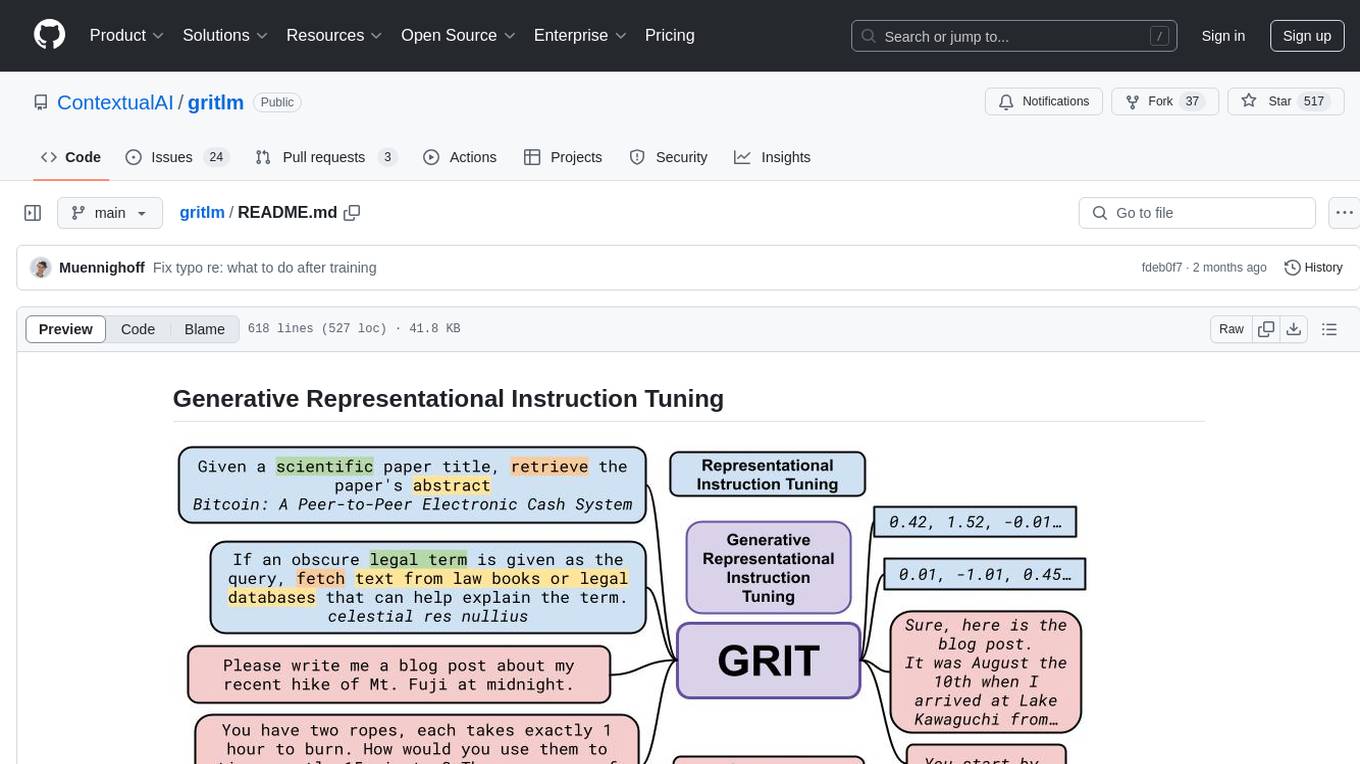
The 'gritlm' repository provides all materials for the paper Generative Representational Instruction Tuning. It includes code for inference, training, evaluation, and known issues related to the GritLM model. The repository also offers models for embedding and generation tasks, along with instructions on how to train and evaluate the models. Additionally, it contains visualizations, acknowledgements, and a citation for referencing the work.
README:
This repository provides all materials for the paper Generative Representational Instruction Tuning. We continue developing the repository and welcome any contributions. If you want to use the code in the exact same way as in the paper, please use the 1.0.0 release (commit hash = 3ac39052ef878371a658a060e69f9c0124bfd59b). 63min video & 30min video on the paper by Niklas Muennighoff; 60min slides link.
pip install gritlm
from gritlm import GritLM
# Loads the model for both capabilities; If you only need embedding pass `mode="embedding"` to save memory (no lm head)
model = GritLM("GritLM/GritLM-7B", torch_dtype="auto")
# To load the 8x7B you will likely need multiple GPUs.
# All the kwargs are passed to HF from_pretrained so you can just do the below to load on multiple GPUs:
# model = GritLM("GritLM/GritLM-8x7B", torch_dtype="auto", device_map="auto")
# You can also load other models e.g.
# model = GritLM("Muennighoff/SGPT-125M-weightedmean-nli-bitfit", pooling_method="weighted_mean", attn=None)
# model = GritLM("hkunlp/instructor-base", pooling_method="mean", attn=None)
### Embedding/Representation ###
instruction = "Given a scientific paper title, retrieve the paper's abstract"
queries = ['Bitcoin: A Peer-to-Peer Electronic Cash System', 'Generative Representational Instruction Tuning']
documents = [
"A purely peer-to-peer version of electronic cash would allow online payments to be sent directly from one party to another without going through a financial institution. Digital signatures provide part of the solution, but the main benefits are lost if a trusted third party is still required to prevent double-spending. We propose a solution to the double-spending problem using a peer-to-peer network. The network timestamps transactions by hashing them into an ongoing chain of hash-based proof-of-work, forming a record that cannot be changed without redoing the proof-of-work. The longest chain not only serves as proof of the sequence of events witnessed, but proof that it came from the largest pool of CPU power. As long as a majority of CPU power is controlled by nodes that are not cooperating to attack the network, they'll generate the longest chain and outpace attackers. The network itself requires minimal structure. Messages are broadcast on a best effort basis, and nodes can leave and rejoin the network at will, accepting the longest proof-of-work chain as proof of what happened while they were gone.",
"All text-based language problems can be reduced to either generation or embedding. Current models only perform well at one or the other. We introduce generative representational instruction tuning (GRIT) whereby a large language model is trained to handle both generative and embedding tasks by distinguishing between them through instructions. Compared to other open models, our resulting GritLM 7B sets a new state of the art on the Massive Text Embedding Benchmark (MTEB) and outperforms all models up to its size on a range of generative tasks. By scaling up further, GritLM 8X7B outperforms all open generative language models that we tried while still being among the best embedding models. Notably, we find that GRIT matches training on only generative or embedding data, thus we can unify both at no performance loss. Among other benefits, the unification via GRIT speeds up Retrieval-Augmented Generation (RAG) by > 60% for long documents, by no longer requiring separate retrieval and generation models. Models, code, etc. are freely available at https://github.com/ContextualAI/gritlm."
]
def gritlm_instruction(instruction):
return "<|user|>\n" + instruction + "\n<|embed|>\n" if instruction else "<|embed|>\n"
# No need to add instruction for retrieval documents
d_rep = model.encode(documents, instruction=gritlm_instruction(""))
q_rep = model.encode(queries, instruction=gritlm_instruction(instruction))
from scipy.spatial.distance import cosine
cosine_sim_q0_d0 = 1 - cosine(q_rep[0], d_rep[0])
cosine_sim_q0_d1 = 1 - cosine(q_rep[0], d_rep[1])
cosine_sim_q1_d0 = 1 - cosine(q_rep[1], d_rep[0])
cosine_sim_q1_d1 = 1 - cosine(q_rep[1], d_rep[1])
print("Cosine similarity between \"%s\" and \"%s\" is: %.3f" % (queries[0][:15], documents[0][:15], cosine_sim_q0_d0))
# Cosine similarity between "Bitcoin: A Peer" and "A purely peer-t" is: 0.608
print("Cosine similarity between \"%s\" and \"%s\" is: %.3f" % (queries[0][:15], documents[1][:15], cosine_sim_q0_d1))
# Cosine similarity between "Bitcoin: A Peer" and "All text-based " is: 0.101
print("Cosine similarity between \"%s\" and \"%s\" is: %.3f" % (queries[1][:15], documents[0][:15], cosine_sim_q1_d0))
# Cosine similarity between "Generative Repr" and "A purely peer-t" is: 0.120
print("Cosine similarity between \"%s\" and \"%s\" is: %.3f" % (queries[1][:15], documents[1][:15], cosine_sim_q1_d1))
# Cosine similarity between "Generative Repr" and "All text-based " is: 0.533
### Generation ###
# We did not finetune GritLM models with system prompts, as you can just include system-like instructions together with your user instruction
messages = [
{"role": "user", "content": "Please write me a poem about my recent hike of Mt. Fuji at midnight in the style of Shakespeare."},
]
encoded = model.tokenizer.apply_chat_template(messages, add_generation_prompt=True, return_tensors="pt")
encoded = encoded.to(model.device)
gen = model.generate(encoded, max_new_tokens=256, do_sample=False)
decoded = model.tokenizer.batch_decode(gen)
print(decoded[0])
"""
<s> <|user|>
Please write me a poem about my recent hike of Mt. Fuji at midnight in the style of Shakespeare.
<|assistant|>
Oh, Mt. Fuji, mountain grand,
A sight to see, a climb to command,
At midnight, in the dark of night,
I climbed your slopes, with all my might.
The stars above, they shone so bright,
A beacon in the darkness, guiding light,
The wind did blow, with a gentle sigh,
As I climbed higher, with a steady eye.
The path was steep, the climb was tough,
But I pressed on, with a steadfast rough,
For the summit, I longed to see,
The view from the top, a sight to be.
At last, I reached the peak, and stood,
With awe and wonder, I gazed aloud,
The world below, a sight to see,
A view that's worth the climb, you'll agree.
Mt. Fuji, mountain grand,
A sight to see, a climb to command,
At midnight, in the dark of night,
I climbed your slopes, with all my might.</s>
"""pip install gritlm
import numpy as np
import torch
from gritlm import GritLM
# Loads the model for both capabilities; If you only need embedding pass `mode="embedding"` to save memory (no lm head)
model = GritLM("GritLM/GritLM-7B", torch_dtype="auto")
# To load the 8x7B you will likely need multiple GPUs.
# All the kwargs are passed to HF from_pretrained so you can just do the below to load on multiple GPUs:
# model = GritLM("GritLM/GritLM-8x7B", torch_dtype="auto", device_map="auto")
# You can also load other models e.g.
# model = GritLM("Muennighoff/SGPT-125M-weightedmean-nli-bitfit", pooling_method="weighted_mean", attn=None)
# model = GritLM("hkunlp/instructor-base", pooling_method="mean", attn=None)
queries = ['Please explain to me how Bitcoin works.', 'What is "Generative Representational Instruction Tuning"?']
documents = [
"A purely peer-to-peer version of electronic cash would allow online payments to be sent directly from one party to another without going through a financial institution. Digital signatures provide part of the solution, but the main benefits are lost if a trusted third party is still required to prevent double-spending. We propose a solution to the double-spending problem using a peer-to-peer network. The network timestamps transactions by hashing them into an ongoing chain of hash-based proof-of-work, forming a record that cannot be changed without redoing the proof-of-work. The longest chain not only serves as proof of the sequence of events witnessed, but proof that it came from the largest pool of CPU power. As long as a majority of CPU power is controlled by nodes that are not cooperating to attack the network, they'll generate the longest chain and outpace attackers. The network itself requires minimal structure. Messages are broadcast on a best effort basis, and nodes can leave and rejoin the network at will, accepting the longest proof-of-work chain as proof of what happened while they were gone.",
"All text-based language problems can be reduced to either generation or embedding. Current models only perform well at one or the other. We introduce generative representational instruction tuning (GRIT) whereby a large language model is trained to handle both generative and embedding tasks by distinguishing between them through instructions. Compared to other open models, our resulting GritLM 7B sets a new state of the art on the Massive Text Embedding Benchmark (MTEB) and outperforms all models up to its size on a range of generative tasks. By scaling up further, GritLM 8X7B outperforms all open generative language models that we tried while still being among the best embedding models. Notably, we find that GRIT matches training on only generative or embedding data, thus we can unify both at no performance loss. Among other benefits, the unification via GRIT speeds up Retrieval-Augmented Generation (RAG) by > 60% for long documents, by no longer requiring separate retrieval and generation models. Models, code, etc. are freely available at https://github.com/ContextualAI/gritlm."
]
CACHE_FORMAT_DOC = "\n<|user|>\n{query}\n\nAnswer the prior query while optionally using the context prior to it\n<|assistant|>\n"
CACHE_FORMAT_QUERY = "\n<|user|>\n{doc}\n\nOptionally using the prior context answer the query prior to it\n<|assistant|>\n"
CACHE_FORMAT_QUERY_DOC = "\n<|user|>\nOptionally using the prior context answer the query prior to it\n<|assistant|>\n"
CACHE_FORMAT_DOC_QUERY = "\n<|user|>\nAnswer the prior query while optionally using the context prior to it\n<|assistant|>\n"
def gritlm_instruction(instruction):
return "<|user|>\n" + instruction + "\n<|embed|>\n" if instruction else "<|embed|>\n"
### GRIT DOC CACHING ###
# cache: Tuple of `tuple(torch.FloatTensor)` of length `config.n_layers`, with each tuple having 2 tensors of shape `(batch_size, num_heads, sequence_length, embed_size_per_head)`
d_rep, d_cache = model.encode(documents, instruction=gritlm_instruction(""), get_cache=True)
q_rep = model.encode(queries, instruction=gritlm_instruction(""))
from scipy.spatial.distance import cosine
sims = {q: [1 - cosine(q_rep[i], d_rep[j]) for j in range(len(d_rep))] for i, q in enumerate(queries)}
for q, q_sims in sims.items():
sim_idx = np.argmax(q_sims)
cache = tuple([
(d_cache[i][0][sim_idx:sim_idx+1], d_cache[i][1][sim_idx:sim_idx+1]) for i, c in enumerate(d_cache)
])
# BOS is already in the cache
inputs = model.tokenizer(CACHE_FORMAT_DOC.format(query=q), return_tensors="pt", add_special_tokens=False).to(model.device)
inputs["use_cache"] = True
# Attend to the cache too
inputs["attention_mask"] = torch.cat((
torch.ones((cache[0][0].shape[0], cache[0][0].shape[2]), dtype=torch.long, device=inputs["attention_mask"].device),
inputs["attention_mask"],
), dim=1)
generation = model.generate(**inputs, max_new_tokens=256, past_key_values=cache, do_sample=False)
decoded = model.tokenizer.batch_decode(generation)
print(decoded[0])
"""
<|user|>
What is "Generative Representational Instruction Tuning"?
Answer the prior query while optionally using the context prior to it
<|assistant|>
Generative Representational Instruction Tuning (GRIT) is a method for training language models that can perform both generative and embedding tasks. It involves training a large language model to handle both types of tasks by distinguishing between them through instructions. GRIT is designed to improve the performance of language models on both generative and embedding tasks, and it can be used to unify both types of tasks at no performance loss.</s>
"""
### GRIT QUERY CACHING ###
# cache: Tuple of `tuple(torch.FloatTensor)` of length `config.n_layers`, with each tuple having 2 tensors of shape `(batch_size, num_heads, sequence_length, embed_size_per_head)`
d_rep = model.encode(documents, instruction=gritlm_instruction(""))
q_rep, q_cache = model.encode(queries, instruction=gritlm_instruction(""), get_cache=True)
from scipy.spatial.distance import cosine
sims = {d: [1 - cosine(q_rep[i], d_rep[j]) for j in range(len(d_rep))] for i, d in enumerate(documents)}
for d, d_sims in sims.items():
sim_idx = np.argmax(d_sims)
cache = tuple([
(q_cache[i][0][sim_idx:sim_idx+1], q_cache[i][1][sim_idx:sim_idx+1]) for i, c in enumerate(q_cache)
])
# BOS is already in the cache
inputs = model.tokenizer(CACHE_FORMAT_QUERY.format(doc=d), return_tensors="pt", add_special_tokens=False).to(model.device)
inputs["use_cache"] = True
# Attend to the cache too
inputs["attention_mask"] = torch.cat((
torch.ones((cache[0][0].shape[0], cache[0][0].shape[2]), dtype=torch.long, device=inputs["attention_mask"].device),
inputs["attention_mask"],
), dim=1)
generation = model.generate(**inputs, max_new_tokens=256, past_key_values=cache, do_sample=False)
decoded = model.tokenizer.batch_decode(generation)
print(decoded[0])
"""
<|user|>
All text-based language problems can be reduced to either generation or embedding. Current models only perform well at one or the other. We introduce generative representational instruction tuning (GRIT) whereby a large language model is trained to handle both generative and embedding tasks by distinguishing between them through instructions. Compared to other open models, our resulting GritLM 7B sets a new state of the art on the Massive Text Embedding Benchmark (MTEB) and outperforms all models up to its size on a range of generative tasks. By scaling up further, GritLM 8X7B outperforms all open generative language models that we tried while still being among the best embedding models. Notably, we find that GRIT matches training on only generative or embedding data, thus we can unify both at no performance loss. Among other benefits, the unification via GRIT speeds up Retrieval-Augmented Generation (RAG) by > 60% for long documents, by no longer requiring separate retrieval and generation models. Models, code, etc. are freely available at https://github.com/ContextualAI/gritlm.
Optionally using the prior context answer the query prior to it
<|assistant|>
GRIT stands for generative representational instruction tuning. It is a method for training large language models to handle both generative and embedding tasks by distinguishing between them through instructions. GritLM is a large language model trained using GRIT that sets a new state of the art on the Massive Text Embedding Benchmark (MTEB) and outperforms all models up to its size on a range of generative tasks. GritLM 8X7B is a larger version of GritLM that outperforms all open generative language models that were tried while still being among the best embedding models. GRIT matches training on only generative or embedding data, thus unifying both at no performance loss. This unification via GRIT speeds up Retrieval-Augmented Generation (RAG) by > 60% for long documents, by no longer requiring separate retrieval and generation models. Models, code, etc. are freely available at <https://github.com/ContextualAI/gritlm>.</s>
"""
### GRIT QUERY-DOC CACHING ###
# cache: Tuple of `tuple(torch.FloatTensor)` of length `config.n_layers`, with each tuple having 2 tensors of shape `(batch_size, num_heads, sequence_length, embed_size_per_head)`
d_rep, d_cache = model.encode(documents, instruction=gritlm_instruction(""), get_cache=True, add_special_tokens=False)
q_rep, q_cache = model.encode(queries, instruction=gritlm_instruction(""), get_cache=True)
from scipy.spatial.distance import cosine
sims = {q: [1 - cosine(q_rep[i], d_rep[j]) for j in range(len(d_rep))] for i, q in enumerate(queries)}
for i, (q, q_sims) in enumerate(sims.items()):
sim_idx = np.argmax(q_sims)
cache_query = tuple([
(q_cache[j][0][i:i+1], q_cache[j][1][i:i+1]) for j, c in enumerate(q_cache)
])
cache_doc = tuple([
(d_cache[j][0][sim_idx:sim_idx+1], d_cache[j][1][sim_idx:sim_idx+1]) for j, c in enumerate(d_cache)
])
# For DOC-QUERY simply swap the order of the cache, change the format to CACHE_FORMAT_DOC_QUERY & set add_special_tokens=True in the `model.encode(..` above
cache = [(
torch.cat((layer[0], cache_doc[i][0]), dim=2),
torch.cat((layer[1], cache_doc[i][1]), dim=2),
) for i, layer in enumerate(cache_query)]
# BOS is already in the cache
inputs = model.tokenizer(CACHE_FORMAT_QUERY_DOC, return_tensors="pt", add_special_tokens=False).to(model.device)
inputs["use_cache"] = True
# Attend to the cache too
inputs["attention_mask"] = torch.cat((
torch.ones((cache[0][0].shape[0], cache[0][0].shape[2]), dtype=torch.long, device=inputs["attention_mask"].device),
inputs["attention_mask"],
), dim=1)
generation = model.generate(**inputs, max_new_tokens=256, past_key_values=cache, do_sample=False)
decoded = model.tokenizer.batch_decode(generation)
print(decoded[0])
"""
<|user|>
Optionally using the prior context answer the query prior to it
<|assistant|>
Sure, here's an example of how the prior context could be used to answer a query:
Query: "What is GRIT?"
Prior context: "We introduce generative representation instruction tuning (GRIT) whereby a large language model is trained to handle both generative and embedding tasks by distinguishing between them through instructions."
Answer: GRIT is a method for training language models to handle both generative and embedding tasks by distinguishing between them through instructions.</s>
"""The weights and logs of all models from the paper are freely available:
- Weights: https://huggingface.co/GritLM
- Logs: https://wandb.ai/muennighoff/gritlm/overview?workspace=user-muennighoff
The names will not always match across HF & WandB, but you can usually figure out which belongs to which via the --output_dir in the command. Note that we renamed all models from sgpt2 to gritlm at some point, so some names/logs/commands contain the old name.
Shortcuts:
- sq = sequence length; sq2048 is 2048 tokens
- ep = epochs; ep1 is 1 epoch
- st = steps; st100 is 100 steps
- m7/m8x7/l7/g6 = base model is Mistral 7B/Mistral 8x7B/Llama 2 7B/GPT-J 6B
- emb/gen/gritlm = embedding, generative, unified
- bf16c = embeddings are cast back to bf16 after pooling and similarity computation is also done in bf16 (simulating how cached embeddings would operate)
- bb/cc/bbcc... = order of bidirectional vs causal attention
- gendups = not using
--use_unique_indicesduring training. If not used and training is unified, then data is duplicated worsening performance
The most important ones are:
| Model | Description | Emb performance (MTEB) | Gen performance |
|---|---|---|---|
| GritLM-7B | 7B parameter model that uses bidirectional attention for embedding and causal attention for generation. It is finetuned from Mistral-7B | 66.8 | 55.5 |
| GritLM-8x7B | 8x7B parameter model that uses bidirectional attention for embedding and causal attention for generation. It is finetuned from Mistral-8x7B | 65.7 | 65.7 |
| Generative-only variant | 7B parameter model generative-only equivalent of GritLM-7B. | 41.2 | 55.2 |
| Embedding-only variant | 7B parameter model embedding-only equivalent of GritLM-7B. | 66.8 | 7.6 |
For GritLM-7B and GritLM-8x7B, the folder contains a custom modeling file (modeling_gritlm*.py) which adds bidirectional attention via the keyword argument is_causal, such that if you load them with from_pretrained in transformers, it is automatically available. We did not add this for any other models uploaded to the organization, thus for those, you need to either add it yourself or simply replace the modeling_mistral.py & modeling_mixtral.py files in your transformers installation with scripts/modeling_mistral_gritlm.py & scripts/modeling_mixtral_gritlm.py. Note that for models that do not use bidirectional attention or when you do not intend to use the bidirectional attention (e.g. for generation), you don't need to do anything.
The repo uses the below format. See training/toy_data.jsonl for an example.
Format:
- Embedding data:
{"query": str, "pos": List[str], "neg": List[str]} - Embedding data with instructions that are excluded from the embedding & loss:
{"query": List[str, str], "pos": List[List[str, str]], "neg": List[List[str, str]]}- The 1st element in the inner list is the instruction and the 2nd is the text to embed.
- Generative data:
{"text": str} - Generative data with instructions that are excluded from the loss:
{"text": List[str]}- The 1st/3rd/5th.. element is the instruction and the 2nd/4th/6th.. is the response. If you only want single-turn chat then just put two elements, for multi-turn put more.
We release the below datasets:
- Embedding:
- MEDI (https://hf.co/datasets/GritLM/MEDI)
- MEDI2 (https://hf.co/datasets/GritLM/MEDI2)
- MEDI2BGE (https://hf.co/datasets/GritLM/MEDI2BGE)
- Generative:
They are explained in more detail in the paper and its appendix. So to e.g. train a GRIT model on MEDI2 & Tulu2, simply download both via git clone https... and then place them in the same directory and follow the instructions below to run. Unfortunately, we cannot release the E5S data used for our final models.
Setup:
# First install PyTorch (https://pytorch.org/get-started/locally/; we used torch==2.2.0 with NVIDIA-SMI 535.104.05, Driver Version: 535.104.05, CUDA Version: 12.2), then do the below
git clone https://github.com/ContextualAI/gritlm
cd gritlm
pip install -e .
# If you want to use GradCache, you need to use the one in this repository
cd gritlm/training/GradCache
pip install -e .
cd ../..Below are easy examples for getting started:
Embedding model
torchrun --nproc_per_node 1 \
-m training.run \
--output_dir test_path \
--model_name_or_path openaccess-ai-collective/tiny-mistral \
--train_data training/toy_data/toy_data_embedding.jsonl \
--learning_rate 1e-5 \
--num_train_epochs 5 \
--per_device_train_batch_size 2 \
--dataloader_drop_last True \
--normalized True \
--temperature 0.02 \
--query_max_len 32 \
--passage_max_len 128 \
--train_group_size 2 \
--mode embedding \
--attn ccccGenerative model
torchrun --nproc_per_node 1 \
-m training.run \
--output_dir test_path \
--model_name_or_path openaccess-ai-collective/tiny-mistral \
--train_data training/toy_data/toy_data_generative.jsonl \
--learning_rate 1e-5 \
--num_train_epochs 5 \
--per_device_train_batch_size 2 \
--dataloader_drop_last True \
--passage_max_len 128 \
--mode generative \
--attn ccccUnified model (GRIT)
torchrun --nproc_per_node 1 \
-m training.run \
--output_dir test_path \
--model_name_or_path openaccess-ai-collective/tiny-mistral \
--train_data training/toy_data \
--learning_rate 1e-5 \
--num_train_epochs 5 \
--per_device_train_batch_size 2 \
--dataloader_drop_last True \
--normalized True \
--temperature 0.02 \
--query_max_len 32 \
--passage_max_len 128 \
--train_group_size 2 \
--mode unified \
--attn ccccAll arguments are explained in training/arguments.py or the HF TrainingArguments documentation except for nproc_per_node which is the number of GPUs per node. For our actual training runs, we use accelerate to easily use multiple nodes and GPUs as well as slightly different settings (e.g. --attn bbcc). The scripts are all in scripts/training, for example scripts/training/train_gritlm_8x7b.sh was used for GritLM-8x7B. For models from the ablations, you can check their folder on the huggingface hub which contains a training_args.bin file with the arguments. You can also check all their arguments on the WandB: https://wandb.ai/muennighoff/gritlm. After training, you may first have to run python scripts/reformat_statedict.py path_to_statedict to remove the model. prefix from the checkpoint, and then you can shard the checkpoint via python scripts/shard.py path_to_model_folder for easier usage.
For the experiments on aligning GritLM with KTO we use https://github.com/huggingface/trl with the scripts in https://github.com/Muennighoff/kto.
cd gritlm
python evaluation/eval_mteb.py \
--model_name_or_path GritLM/GritLM-7B \
--task_types Classification,Clustering,PairClassification,Reranking,Retrieval,STS,Summarization \
--batch_size 32For a faster way, check scripts/eval_mteb.sh which submits jobs across multiple GPUs for each dataset.
## Setup
# Setup eval for MMLU/GSM8K/BBH/TyDi QA/Alpaca
git clone https://github.com/Muennighoff/open-instruct.git
cd open-instruct
pip install -r requirements.txt
bash ./scripts/prepare_eval_data.sh
cd ..
# Setup eval for HumanEvalPack
git clone https://github.com/bigcode-project/bigcode-evaluation-harness
cd bigcode-evaluation-harness
pip install -e .
cd ..
MODEL_PATH=GritLM/gritlm-7b
# Run all evals except for Alpaca; You may have to change some paths etc.
bash scripts/generative_eval.sh {path to model}
# Run Alpaca 1.0
export OPENAI_API_KEY=YOUR_API_KEY
python -m eval.alpaca_farm.run_eval \
--use_vllm \
--model_name_or_path $MODEL_PATH \
--tokenizer_name_or_path $MODEL_PATH \
--save_dir ./ \
--use_chat_format \
--chat_formatting_function eval.templates.create_prompt_with_gritlm_chat_format
# Alpaca 2.0 (not used in the paper)
python -m eval.alpaca_farm.run_eval \
--use_vllm \
--model_name_or_path $MODEL_PATH \
--tokenizer_name_or_path $MODEL_PATH \
--save_dir $MODEL_PATH \
--use_chat_format \
--chat_formatting_function eval.templates.create_prompt_with_gritlm_chat_format \
--alpaca2- If you train on many nodes + a large model + fsdp, you may encounter timeouts upon checkpoint saving with
FULL_STATE_DICT. For example, training Mixtral on 32 nodes with 8 GPUs each, fails with the below. Usually the main node will finish the saving unless they are all in the same job manager who kills it. Unfortunately increasing the timeout limit seems not possibe? (https://discuss.pytorch.org/t/how-to-set-nccl-timeout-to-infinity/146006 ; https://github.com/huggingface/accelerate/issues/2236#issuecomment-1864809701) So the current solution is just to use less nodes or ensure the saving process does not get killed. Please let us know if you have a better solution.
[dojo-a3-ghpc-9:1]: what(): [Rank 1] NCCL watchdog thread terminated with exception: [Rank 1] Watchdog caught collective operation timeout: WorkNCCL(SeqNum=683, OpType=_ALLGATHER_BASE, NumelIn=32768512, NumelOut=262148096, Timeout(ms)=600000) ran for 600032 milliseconds before timing out.- Add Packing at least for gen, maybe also possible for emb; Need to be careful with the NextTokenLoss
- QLoRa / LoRa integration is not well-tested
RuntimeError: one of the variables needed for gradient computation has been modified by an inplace operation: [torch.cuda.LongTensor [20, 2048]] is at version 21; expected version 0 instead. Hint: enable anomaly detection to find the operation that failed to compute its gradient, with torch.autograd.set_detect_anomaly(True).- If you run into the below error when doing multi-node training, try this https://github.com/huggingface/transformers/issues/26971#issuecomment-1868137087
load_state_dict_into_meta_model
set_module_tensor_to_device(model, param_name, param_device, **set_module_kwargs)
File "/env/lib/conda/gritlm/lib/python3.9/site-packages/accelerate/utils/modeling.py", line 317, in set_module_tensor_to_device
new_value = value.to(device)
NotImplementedError: Cannot copy out of meta tensor; no data!- DeepSpeed does not work with
--mode unifiedand--gradient_accumulation_stepsbigger than 1 (i.e. GradCache) (FSDP is ~equivalent so this is not high prio) -
fsdp_use_orig_params: truein the accelerate config is critical for performance, else it may not converge at all (see comparisons in the wandb runs) - If you get the below error where training fails on saving, then upgrade accelerate & transformers
508 01/06/2024 08:28:40 - INFO - accelerate.utils.fsdp_utils - Model saved to /data/niklas/gritlm/gritlm_mist_sq2048_medibgetuluv2_tuluformat_8nodes_oldtracc/tmp-checkpoint-500/pytorch_model.bin
509 01/06/2024 08:30:24 - INFO - accelerate.utils.fsdp_utils - Saving Optimizer state to /data/niklas/gritlm/gritlm_mist_sq2048_medibgetuluv2_tuluformat_8nodes_oldtracc/tmp-checkpoint-500/optimizer.bin
510 Traceback (most recent call last):
511 File "/env/lib/conda/gritlmold/lib/python3.9/runpy.py", line 197, in _run_module_as_main
512 return _run_code(code, main_globals, None,
513 File "/env/lib/conda/gritlmold/lib/python3.9/runpy.py", line 87, in _run_code
514 exec(code, run_globals)
515 File "/home/niklas/gritlm/training/run.py", line 421, in <module>
516 main()
517 File "/home/niklas/gritlm/training/run.py", line 411, in main
518 trainer.train()
519 File "/env/lib/conda/gritlmold/lib/python3.9/site-packages/transformers/trainer.py", line 1537, in train
520 return inner_training_loop(
521 File "/home/niklas/gritlm/training/gradcache_trainer.py", line 962, in _inner_training_loop
522 self._maybe_log_save_evaluate(tr_loss, model, trial, epoch, ignore_keys_for_eval)
523 File "/env/lib/conda/gritlmold/lib/python3.9/site-packages/transformers/trainer.py", line 2274, in _maybe_log_save_evaluate
524 self._save_checkpoint(model, trial, metrics=metrics)
525 File "/env/lib/conda/gritlmold/lib/python3.9/site-packages/transformers/trainer.py", line 2354, in _save_checkpoint
526 self._save_optimizer_and_scheduler(staging_output_dir)
527 File "/env/lib/conda/gritlmold/lib/python3.9/site-packages/transformers/trainer.py", line 2445, in _save_optimizer_and_scheduler
528 save_fsdp_optimizer(
529 File "/env/lib/conda/gritlmold/lib/python3.9/site-packages/accelerate/utils/fsdp_utils.py", line 146, in save_fsdp_optimizer
530 torch.save(optim_state, output_optimizer_file)
531 File "/env/lib/conda/gritlmold/lib/python3.9/site-packages/torch/serialization.py", line 618, in save
532 with _open_zipfile_writer(f) as opened_zipfile:
533 File "/env/lib/conda/gritlmold/lib/python3.9/site-packages/torch/serialization.py", line 492, in _open_zipfile_writer
534 return container(name_or_buffer)
535 File "/env/lib/conda/gritlmold/lib/python3.9/site-packages/torch/serialization.py", line 463, in __init__
536 super().__init__(torch._C.PyTorchFileWriter(self.name))
537 RuntimeError: Parent directory /data/niklas/gritlm/gritlm_mist_sq2048_medibgetuluv2_tuluformat_8nodes_oldtracc/tmp-checkpoint-500 does not exist.- If loss is slightly different when changing the number of gradient accumulation steps, this is expected because torch uses weighted mean averaging in its CrossEntropyLoss by default. As the language modeling objective occasionally has the same token being predicted multiple times in one batch, this will result in a different loss when splitting up batches. Meanwhile, for the embedding loss every class id is only predicted once, thus weighted mean is equivalent to mean for embedding (https://github.com/pytorch/pytorch/issues/72047; https://github.com/pytorch/pytorch/issues/40560; https://github.com/pytorch/pytorch/issues/107680).
- Another reason loss is different when changing the number of processes is that the data order may be different. While all seeds are being set, accelerate.prepare of the data loader in the trainer, sets up the dataloader such that it iterates one sample ahead of time. Thus, on the first iteration it gets two batches for each process instead of one. Somehow, this causes one sample in the first batch to land in the subsequent batch when going from 0 to 8 gpus. I could not figure out why exactly, but investigations are appreciated.
- Training with fp32 generally converges much faster than with bf16. Changing the allreduce and buffer dtypes to fp32 does not change this (https://github.com/NVIDIA/Megatron-LM/issues/502; https://github.com/pytorch/pytorch/issues/106395). However, in the ablations of the paper it actually did not perform better to do fully fp32.
- torch.compile fails with the below in unified mode (also see https://github.com/pytorch/pytorch/issues/111317):
from user code:
File "/env/lib/conda/gritlmnew/lib/python3.9/site-packages/transformers/models/mistral/mode
ling_mistral.py", line 757, in forward
hidden_states = self.input_layernorm(hidden_states)
File "/env/lib/conda/gritlmnew/lib/python3.9/site-packages/torch/nn/modules/module.py", line
1527, in _call_impl
return forward_call(*args, **kwargs)
File "/env/lib/conda/gritlmnew/lib/python3.9/site-packages/transformers/models/mistral/model
ing_mistral.py", line 89, in forward
return self.weight * hidden_states.to(input_dtype)
Set TORCH_LOGS="+dynamo" and TORCHDYNAMO_VERBOSE=1 for more information
You can suppress this exception and fall back to eager by setting:
import torch._dynamo
torch._dynamo.config.suppress_errors = True
example_value = wrap_to_fake_tensor_and_record(
File "/env/lib/conda/gritlmnew/lib/python3.9/site-packages/torch/_dynamo/variables/builder.p
y", line 1587, in wrap_to_fake_tensor_and_record
fake_e = wrap_fake_exception(
File "/env/lib/conda/gritlmnew/lib/python3.9/site-packages/torch/_dynamo/utils.py", line 916
, in wrap_fake_exception
return fn()
File "/env/lib/conda/gritlmnew/lib/python3.9/site-packages/torch/_dynamo/variables/builder.p
y", line 1588, in <lambda>
lambda: tx.fake_mode.from_tensor(
File "/env/lib/conda/gritlmnew/lib/python3.9/site-packages/torch/_subclasses/fake_tensor.py"
, line 1721, in from_tensor
return self.fake_tensor_converter(
File "/env/lib/conda/gritlmnew/lib/python3.9/site-packages/torch/_subclasses/fake_tensor.py"
, line 371, in __call__
return self.from_real_tensor(
File "/env/lib/conda/gritlmnew/lib/python3.9/site-packages/torch/_subclasses/fake_tensor.py"
, line 324, in from_real_tensor
out = self.meta_converter(
File "/env/lib/conda/gritlmnew/lib/python3.9/site-packages/torch/_subclasses/meta_utils.py",
line 591, in __call__
r = self.meta_tensor(
File "/env/lib/conda/gritlmnew/lib/python3.9/site-packages/torch/_subclasses/meta_utils.py",
line 307, in meta_tensor
base = self.meta_tensor(
File "/env/lib/conda/gritlmnew/lib/python3.9/site-packages/torch/_subclasses/meta_utils.py",
line 478, in meta_tensor
r.grad = self.meta_tensor(
torch._dynamo.exc.InternalTorchDynamoError: attempting to assign a gradient of size '[2726400
0]' to a tensor of size '[218112000]'. Please ensure that the gradient and the tensor are the
same size- DeepSpeed + FlashAttention2 + Optim & Params offloaded to CPU + DeepSpeed ZeRo3 init fails:
s. (Triggered internally at /opt/conda/conda-bld/pytorch_1702400412039/work/torch/csrc/t
ensor/python_tensor.cpp:83.)
total_norm_cuda = get_accelerator().FloatTensor([float(total_norm)])
Invalidate trace cache @ step 1: expected module 1, but got module 2
[E ProcessGroupNCCL.cpp:475] [Rank 1] Watchdog caught collective operation timeout: Work- If implementing full splitting + GC you may run into
File "/home/niklas/gritlm/training/gradcache_trainer.py", line 630, in _inner_training_loop
self.accelerator.backward(loss)
File "/env/lib/conda/gritlmnew/lib/python3.9/site-packages/accelerate/accelerator.py", line 1964, in backward
loss.backward(**kwargs)
File "/env/lib/conda/gritlmnew/lib/python3.9/site-packages/torch/_tensor.py", line 492, in backward
torch.autograd.backward(
File "/env/lib/conda/gritlmnew/lib/python3.9/site-packages/torch/autograd/__init__.py", line 251, in backward
Variable._execution_engine.run_backward( # Calls into the C++ engine to run the backward pass
File "/env/lib/conda/gritlmnew/lib/python3.9/site-packages/torch/utils/checkpoint.py", line 1075, in unpack_hook
frame.check_recomputed_tensors_match(gid)
File "/env/lib/conda/gritlmnew/lib/python3.9/site-packages/torch/utils/checkpoint.py", line 812, in check_recomp
uted_tensors_match
raise CheckpointError(
torch.utils.checkpoint.CheckpointError: torch.utils.checkpoint: A different number of tensors was saved during th
e original forward and recomputation.
Number of tensors saved during forward: 47
Number of tensors saved during recomputation: 45 - Figure 1:
visuals/performance.pdf;visuals/grit_plots.ipynb/ colab & then add in logos viavisuals/performance.drawiothat can be opened with https://app.diagrams.net/, then add blurbs in viavisuals/performance.keythat can be opened in Keynote. - Figure 2:
visuals/octopus.pdf; https://docs.google.com/drawings/d/1ZAzaX4h2JfJR1ahan0R5nk3Xm17SMquGjhshnBNJOzY/edit?usp=sharing - Figure 3:
visuals/format.pdf; https://docs.google.com/drawings/d/1vaSNvDWy6xBBuC70rI22qdOmymksxqoTYiplGPH22ys/edit?usp=sharing - Figure 4:
visuals/rag.pdf; https://docs.google.com/drawings/d/1rv916zpYvBbaS6QxpFP4_6fc4gABcPWc2qZC3NUpz8s/edit?usp=sharing - Figure 5/6/7/8:
visuals/latency.pdf/visuals/loss7.pdf/visuals/loss8x7.pdf/visuals/embmem.pdf;visuals/grit_plots.ipynb/ colab - Other figures & tables are manual, but there are helper scripts, such as
scripts/mteb_to_tex.py
The code is inspired by:
- https://github.com/Muennighoff/sgpt
- https://github.com/FlagOpen/FlagEmbedding
- https://github.com/embeddings-benchmark/mteb
Please see additional acknowledgments in the paper.
If useful please consider citing 😊
@misc{muennighoff2024generative,
title={Generative Representational Instruction Tuning},
author={Niklas Muennighoff and Hongjin Su and Liang Wang and Nan Yang and Furu Wei and Tao Yu and Amanpreet Singh and Douwe Kiela},
year={2024},
eprint={2402.09906},
archivePrefix={arXiv},
primaryClass={cs.CL}
}For Tasks:
Click tags to check more tools for each tasksFor Jobs:
Alternative AI tools for gritlm
Similar Open Source Tools

gritlm
The 'gritlm' repository provides all materials for the paper Generative Representational Instruction Tuning. It includes code for inference, training, evaluation, and known issues related to the GritLM model. The repository also offers models for embedding and generation tasks, along with instructions on how to train and evaluate the models. Additionally, it contains visualizations, acknowledgements, and a citation for referencing the work.
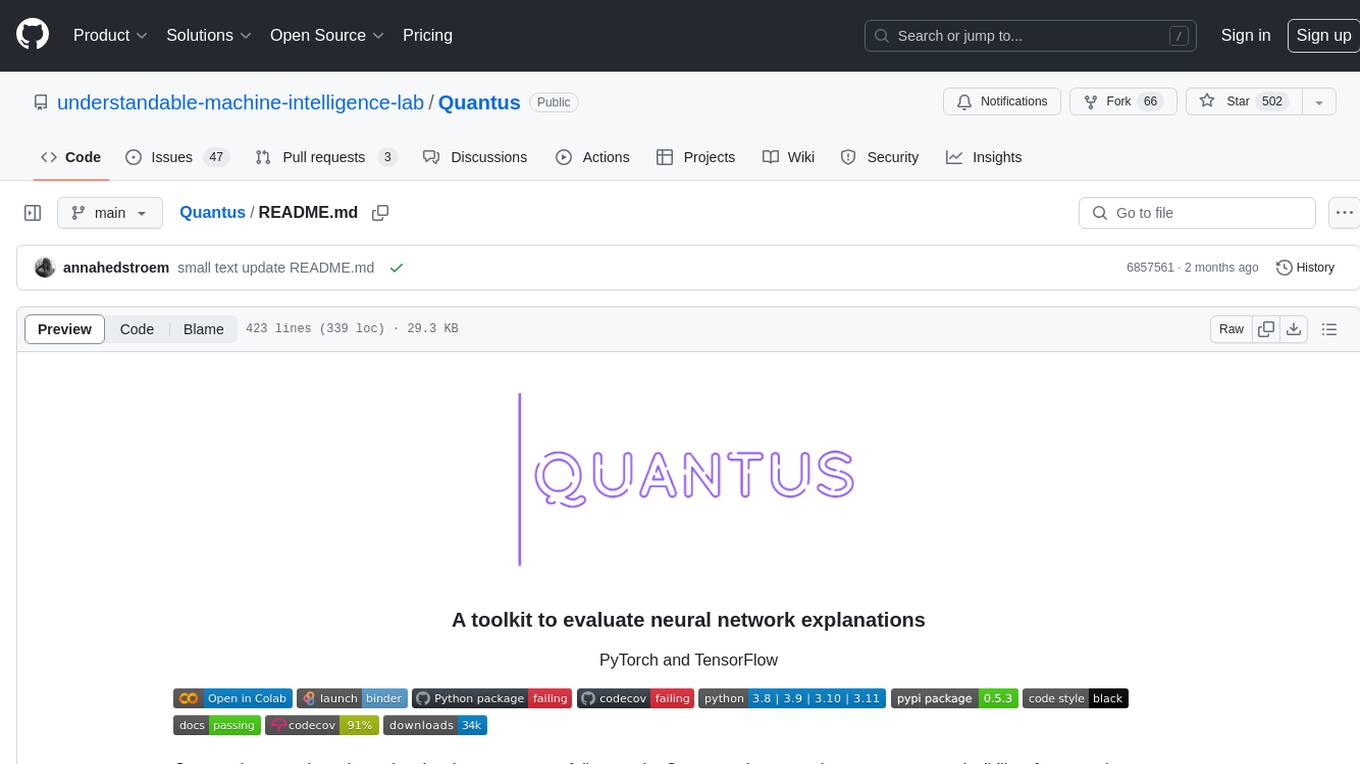
Quantus
Quantus is a toolkit designed for the evaluation of neural network explanations. It offers more than 30 metrics in 6 categories for eXplainable Artificial Intelligence (XAI) evaluation. The toolkit supports different data types (image, time-series, tabular, NLP) and models (PyTorch, TensorFlow). It provides built-in support for explanation methods like captum, tf-explain, and zennit. Quantus is under active development and aims to provide a comprehensive set of quantitative evaluation metrics for XAI methods.
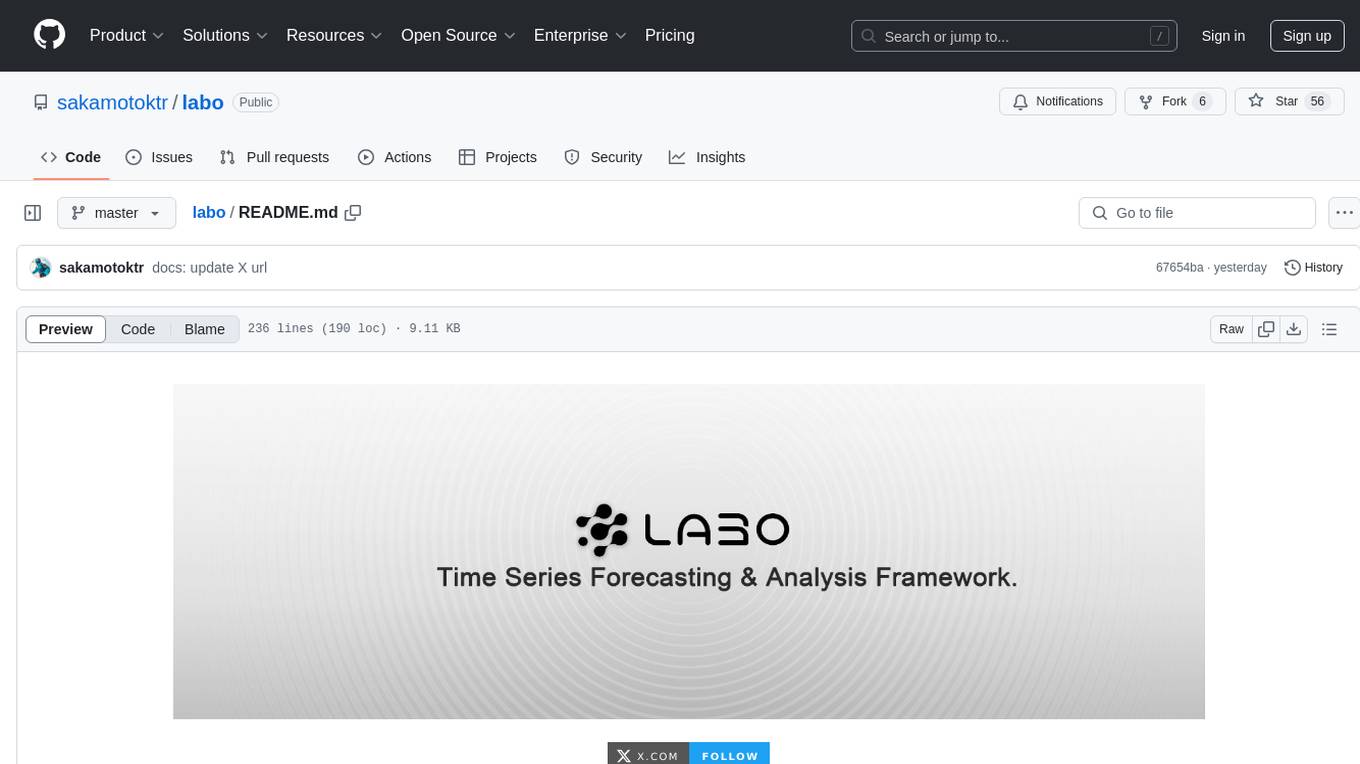
labo
LABO is a time series forecasting and analysis framework that integrates pre-trained and fine-tuned LLMs with multi-domain agent-based systems. It allows users to create and tune agents easily for various scenarios, such as stock market trend prediction and web public opinion analysis. LABO requires a specific runtime environment setup, including system requirements, Python environment, dependency installations, and configurations. Users can fine-tune their own models using LABO's Low-Rank Adaptation (LoRA) for computational efficiency and continuous model updates. Additionally, LABO provides a Python library for building model training pipelines and customizing agents for specific tasks.
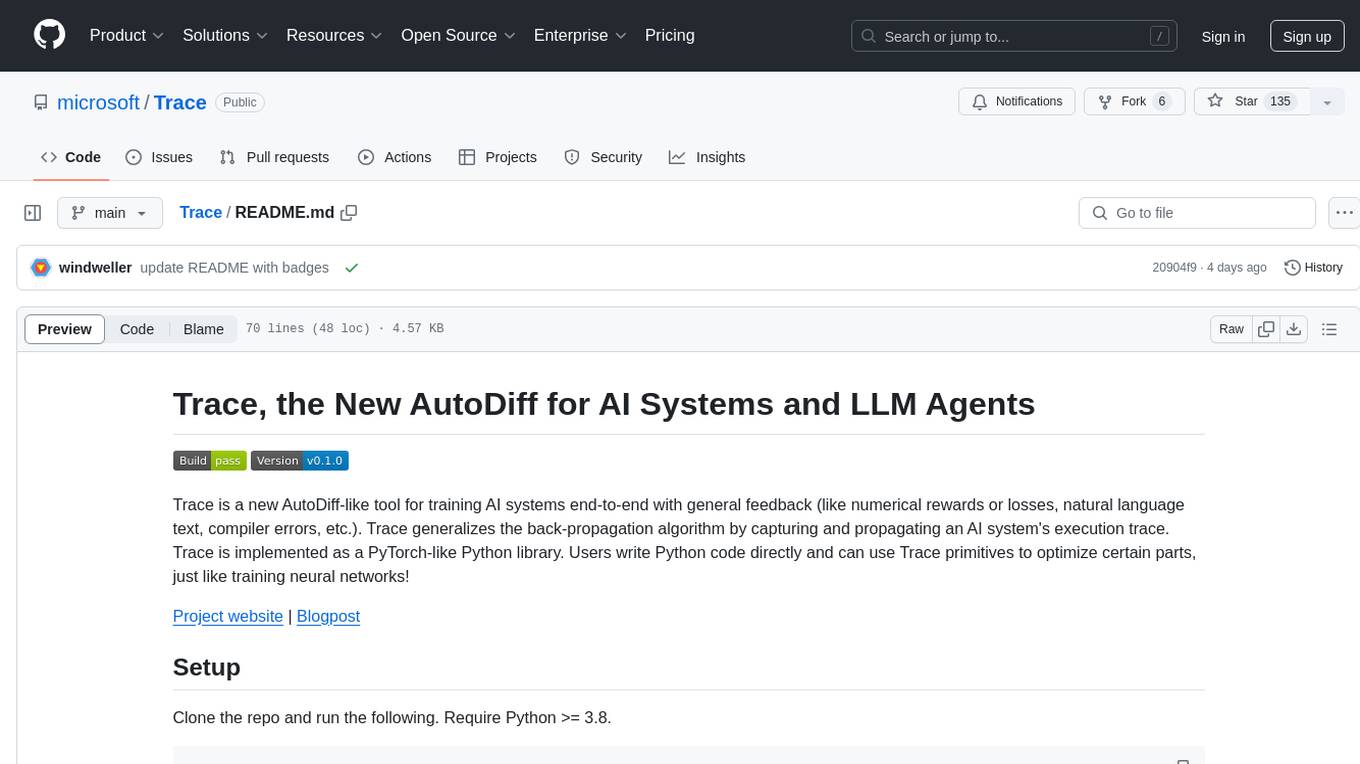
Trace
Trace is a new AutoDiff-like tool for training AI systems end-to-end with general feedback. It generalizes the back-propagation algorithm by capturing and propagating an AI system's execution trace. Implemented as a PyTorch-like Python library, users can write Python code directly and use Trace primitives to optimize certain parts, similar to training neural networks.
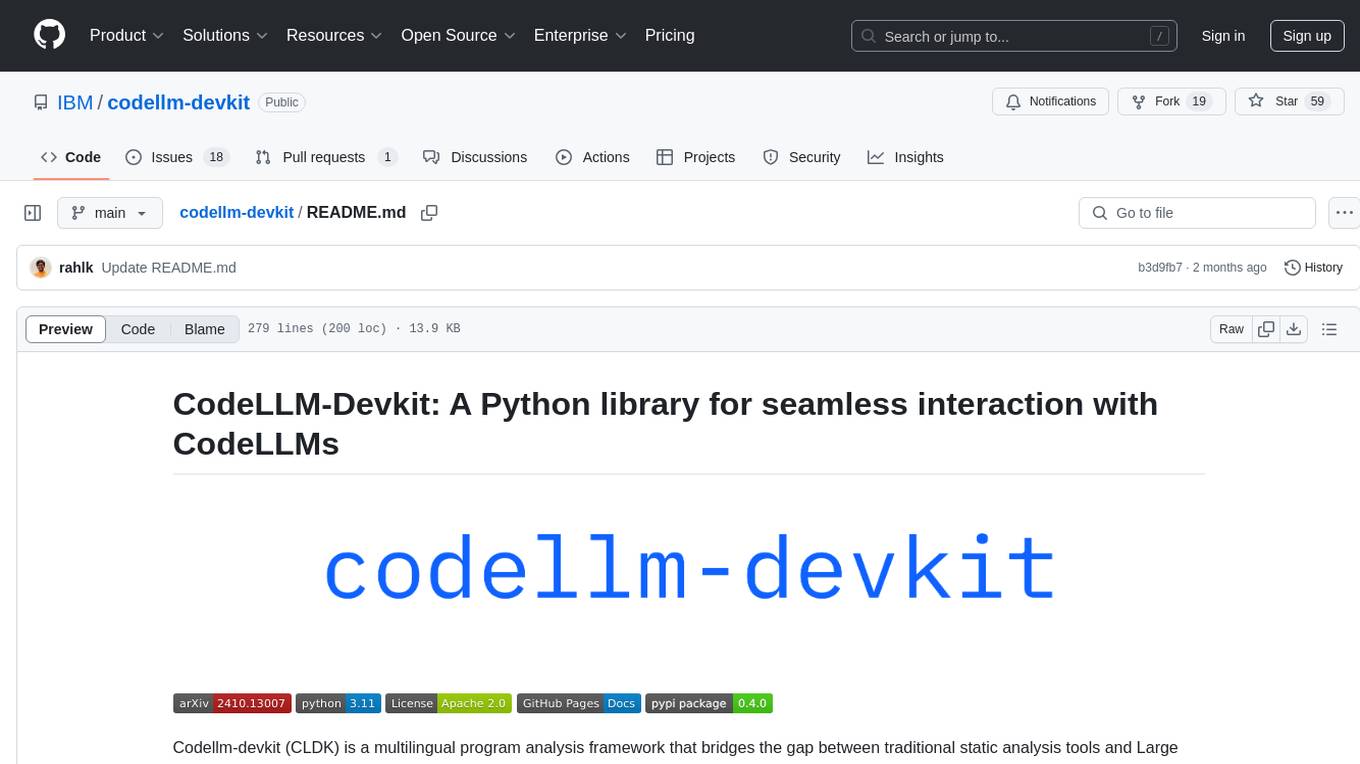
codellm-devkit
Codellm-devkit (CLDK) is a Python library that serves as a multilingual program analysis framework bridging traditional static analysis tools and Large Language Models (LLMs) specialized for code (CodeLLMs). It simplifies the process of analyzing codebases across multiple programming languages, enabling the extraction of meaningful insights and facilitating LLM-based code analysis. The library provides a unified interface for integrating outputs from various analysis tools and preparing them for effective use by CodeLLMs. Codellm-devkit aims to enable the development and experimentation of robust analysis pipelines that combine traditional program analysis tools and CodeLLMs, reducing friction in multi-language code analysis and ensuring compatibility across different tools and LLM platforms. It is designed to seamlessly integrate with popular analysis tools like WALA, Tree-sitter, LLVM, and CodeQL, acting as a crucial intermediary layer for efficient communication between these tools and CodeLLMs. The project is continuously evolving to include new tools and frameworks, maintaining its versatility for code analysis and LLM integration.
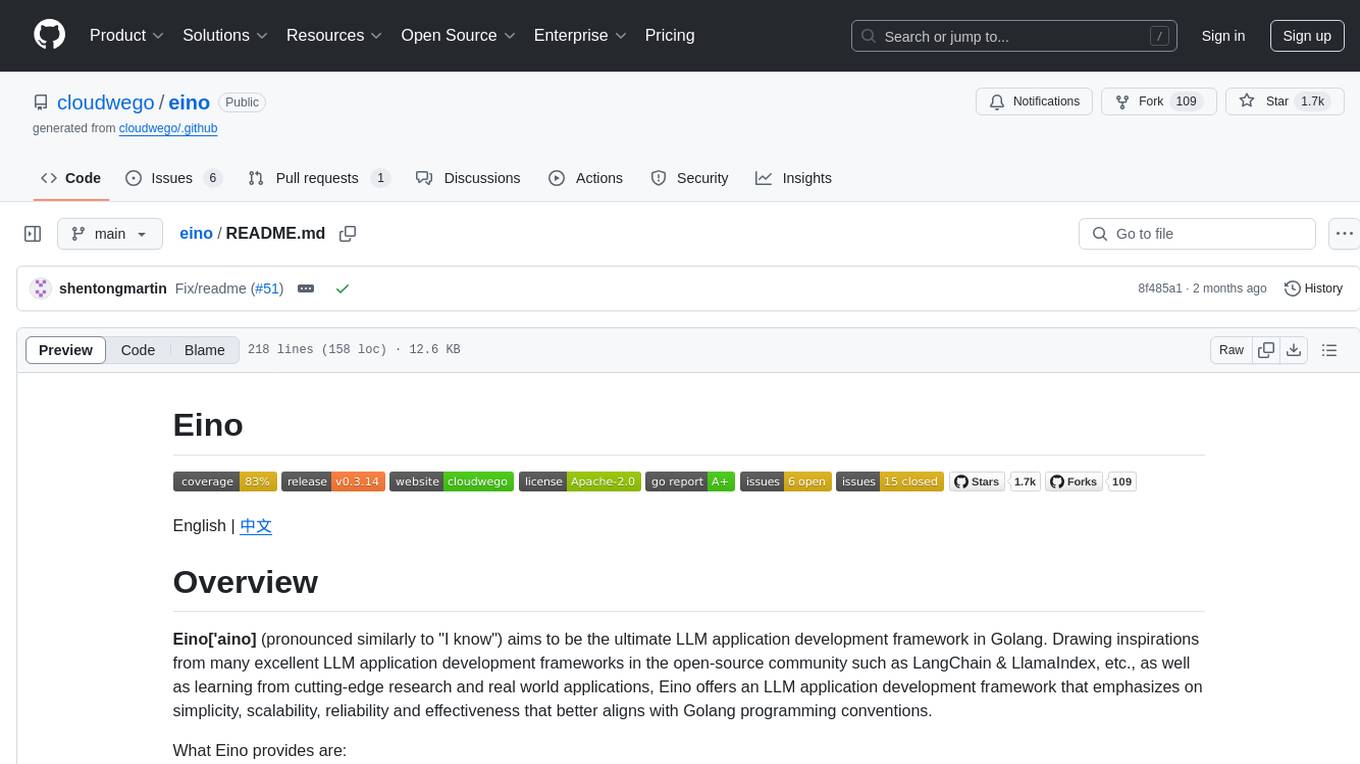
eino
Eino is an ultimate LLM application development framework in Golang, emphasizing simplicity, scalability, reliability, and effectiveness. It provides a curated list of component abstractions, a powerful composition framework, meticulously designed APIs, best practices, and tools covering the entire development cycle. Eino standardizes and improves efficiency in AI application development by offering rich components, powerful orchestration, complete stream processing, highly extensible aspects, and a comprehensive framework structure.
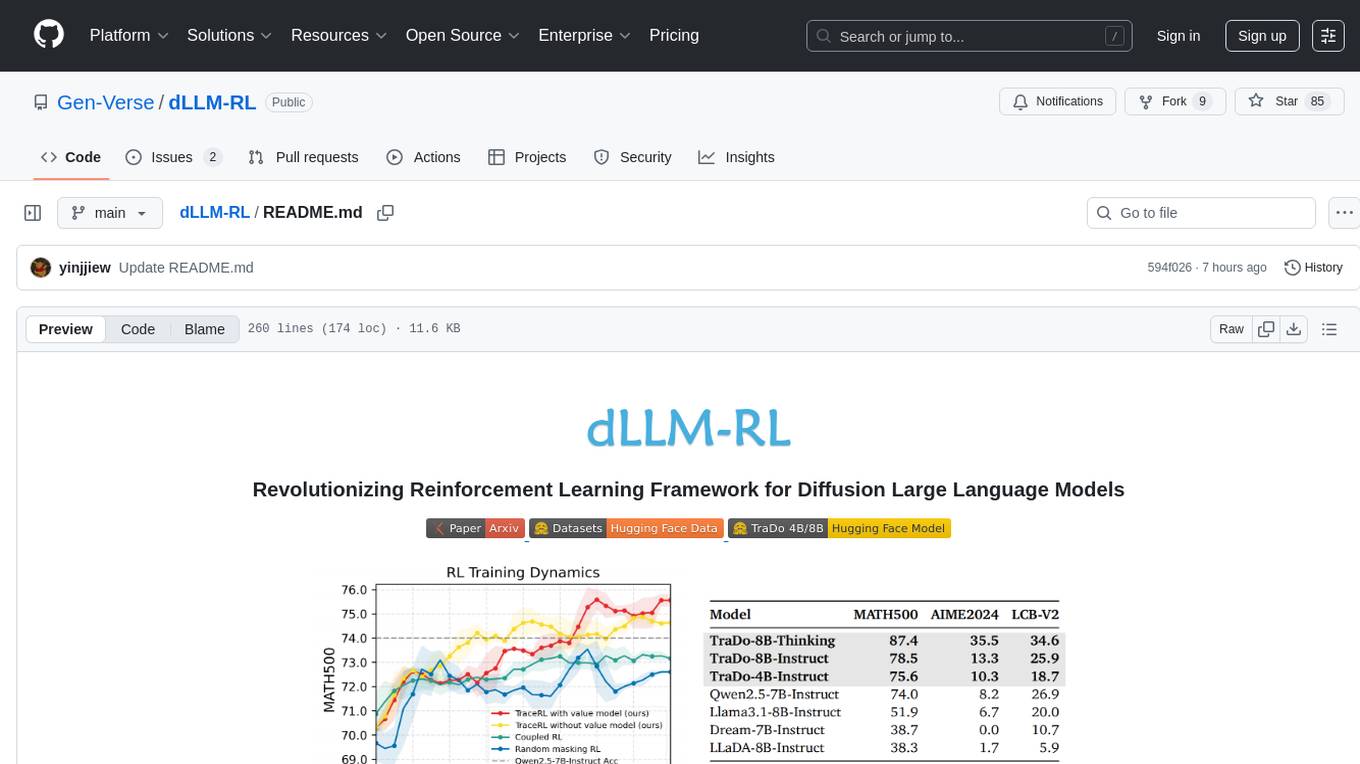
dLLM-RL
dLLM-RL is a revolutionary reinforcement learning framework designed for Diffusion Large Language Models. It supports various models with diverse structures, offers inference acceleration, RL training capabilities, and SFT functionalities. The tool introduces TraceRL for trajectory-aware RL and diffusion-based value models for optimization stability. Users can download and try models like TraDo-4B-Instruct and TraDo-8B-Instruct. The tool also provides support for multi-node setups and easy building of reinforcement learning methods. Additionally, it offers supervised fine-tuning strategies for different models and tasks.
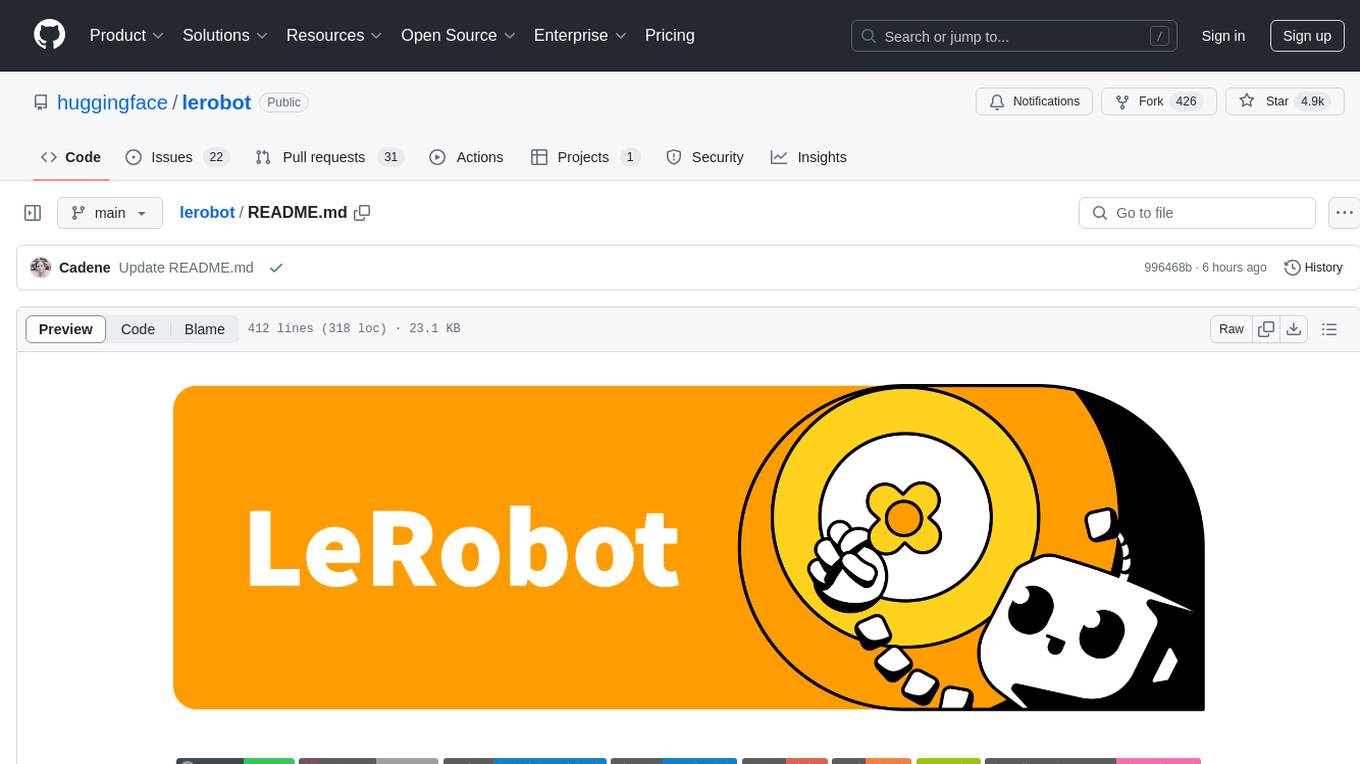
lerobot
LeRobot is a state-of-the-art AI library for real-world robotics in PyTorch. It aims to provide models, datasets, and tools to lower the barrier to entry to robotics, focusing on imitation learning and reinforcement learning. LeRobot offers pretrained models, datasets with human-collected demonstrations, and simulation environments. It plans to support real-world robotics on affordable and capable robots. The library hosts pretrained models and datasets on the Hugging Face community page.
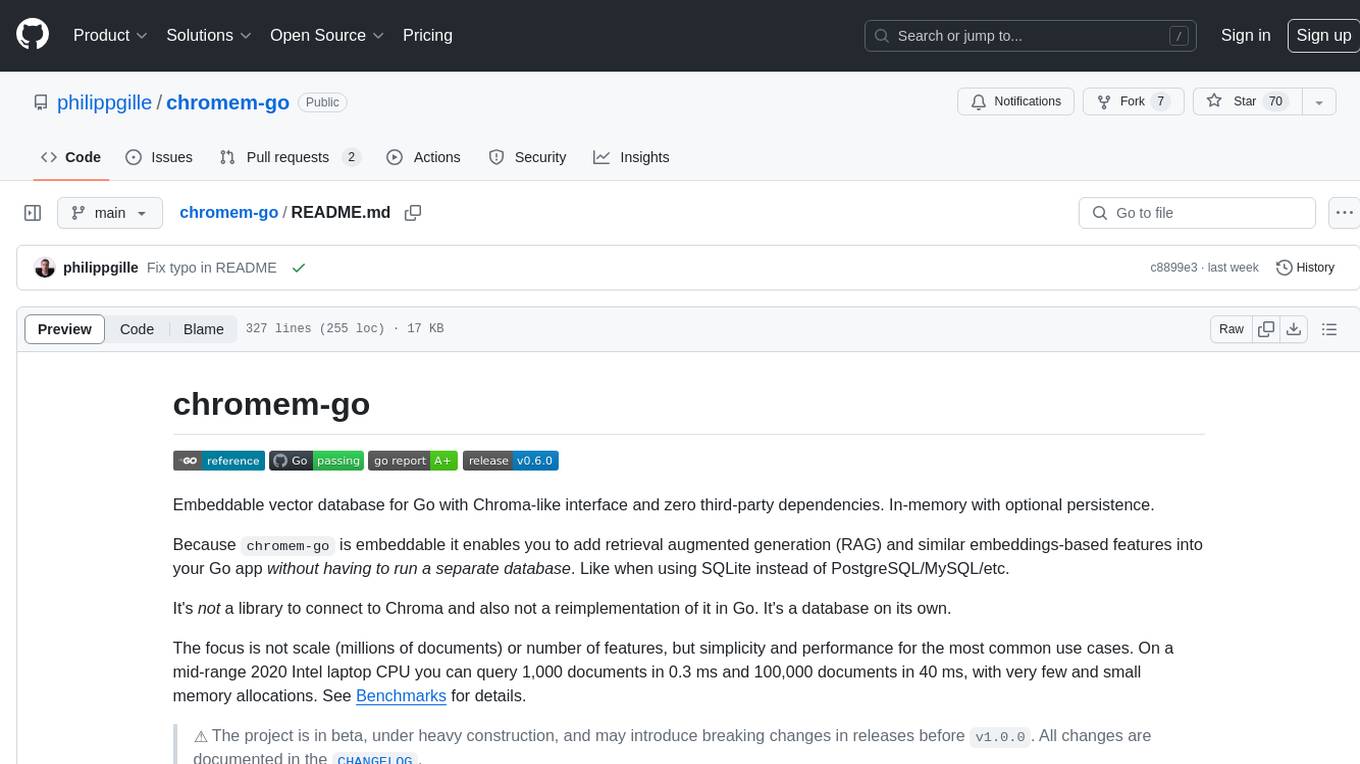
chromem-go
chromem-go is an embeddable vector database for Go with a Chroma-like interface and zero third-party dependencies. It enables retrieval augmented generation (RAG) and similar embeddings-based features in Go apps without the need for a separate database. The focus is on simplicity and performance for common use cases, allowing querying of documents with minimal memory allocations. The project is in beta and may introduce breaking changes before v1.0.0.
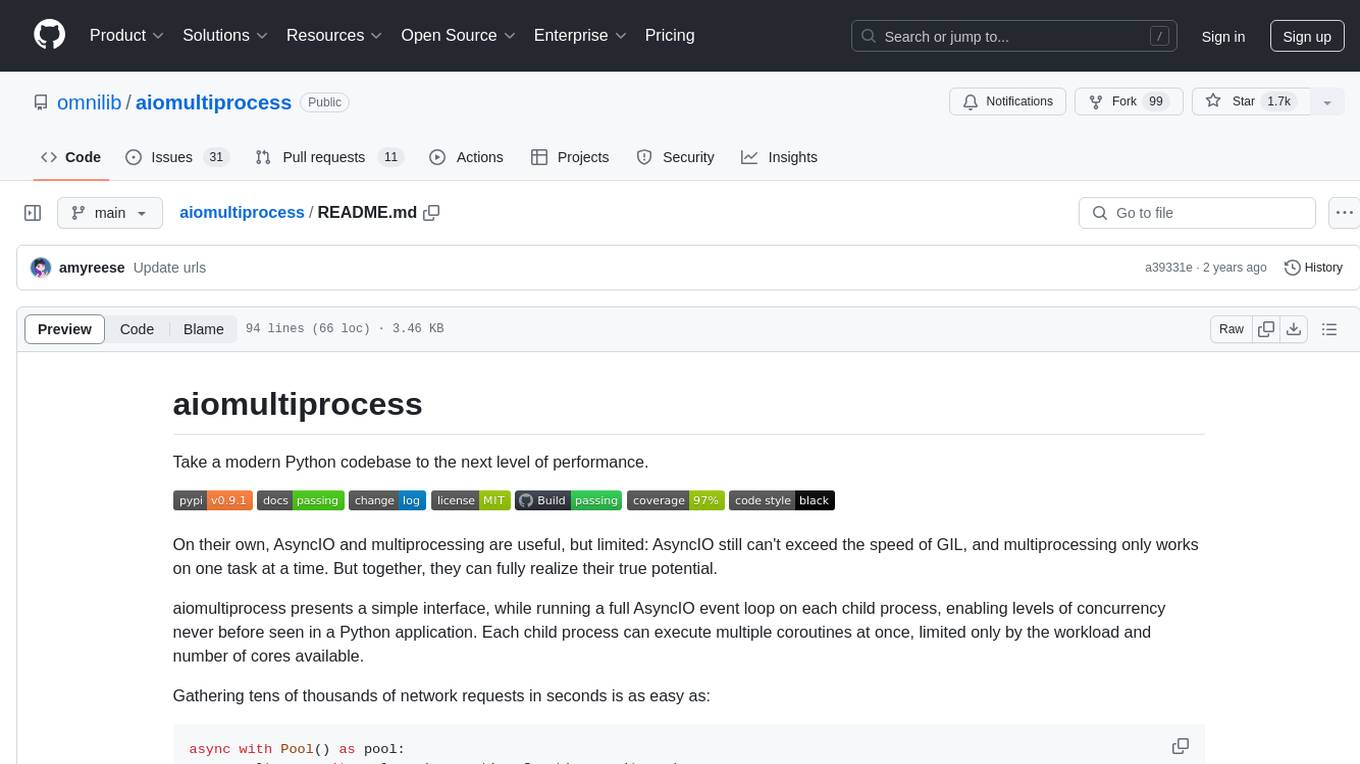
aiomultiprocess
aiomultiprocess is a Python library that combines AsyncIO and multiprocessing to achieve high levels of concurrency in Python applications. It allows running a full AsyncIO event loop on each child process, enabling multiple coroutines to execute simultaneously. The library provides a simple interface for executing asynchronous tasks on a pool of worker processes, making it easy to gather large amounts of network requests quickly. aiomultiprocess is designed to take Python codebases to the next level of performance by leveraging the combined power of AsyncIO and multiprocessing.
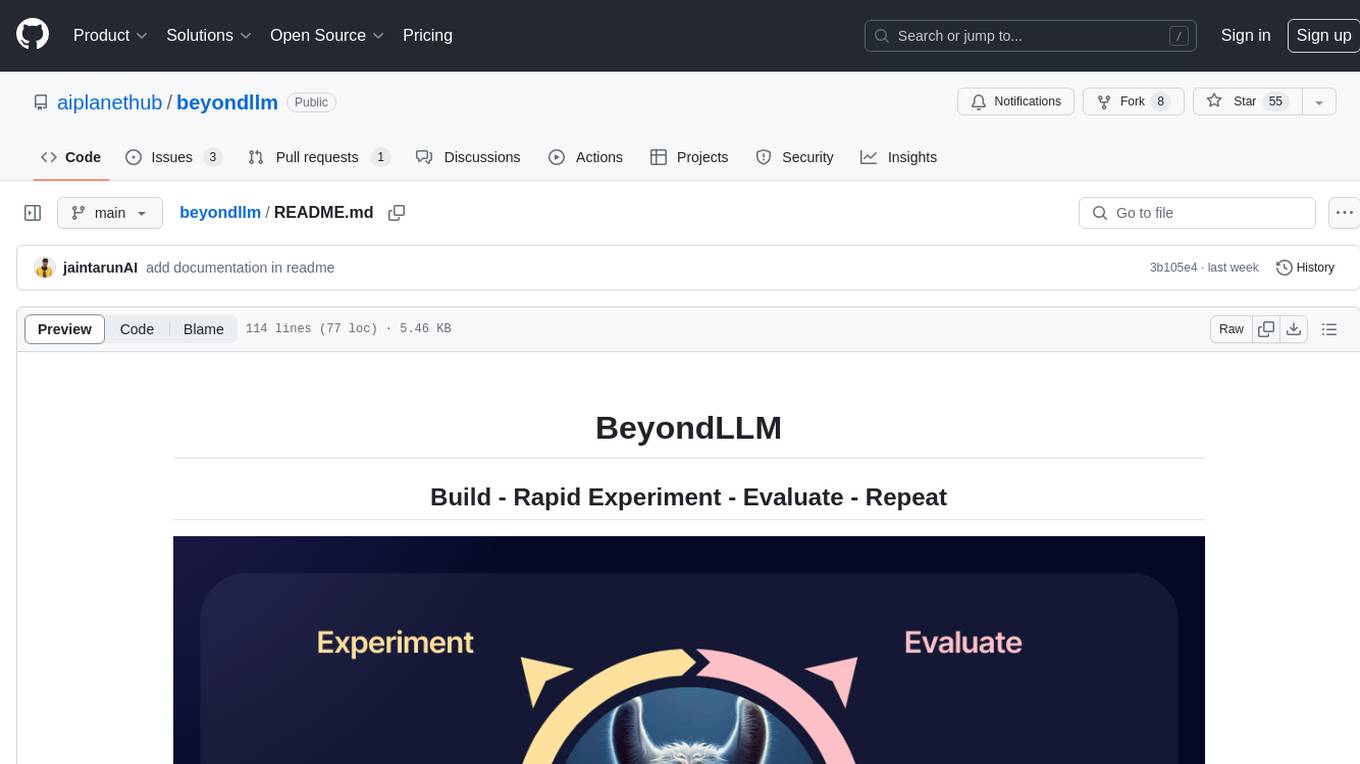
beyondllm
Beyond LLM offers an all-in-one toolkit for experimentation, evaluation, and deployment of Retrieval-Augmented Generation (RAG) systems. It simplifies the process with automated integration, customizable evaluation metrics, and support for various Large Language Models (LLMs) tailored to specific needs. The aim is to reduce LLM hallucination risks and enhance reliability.
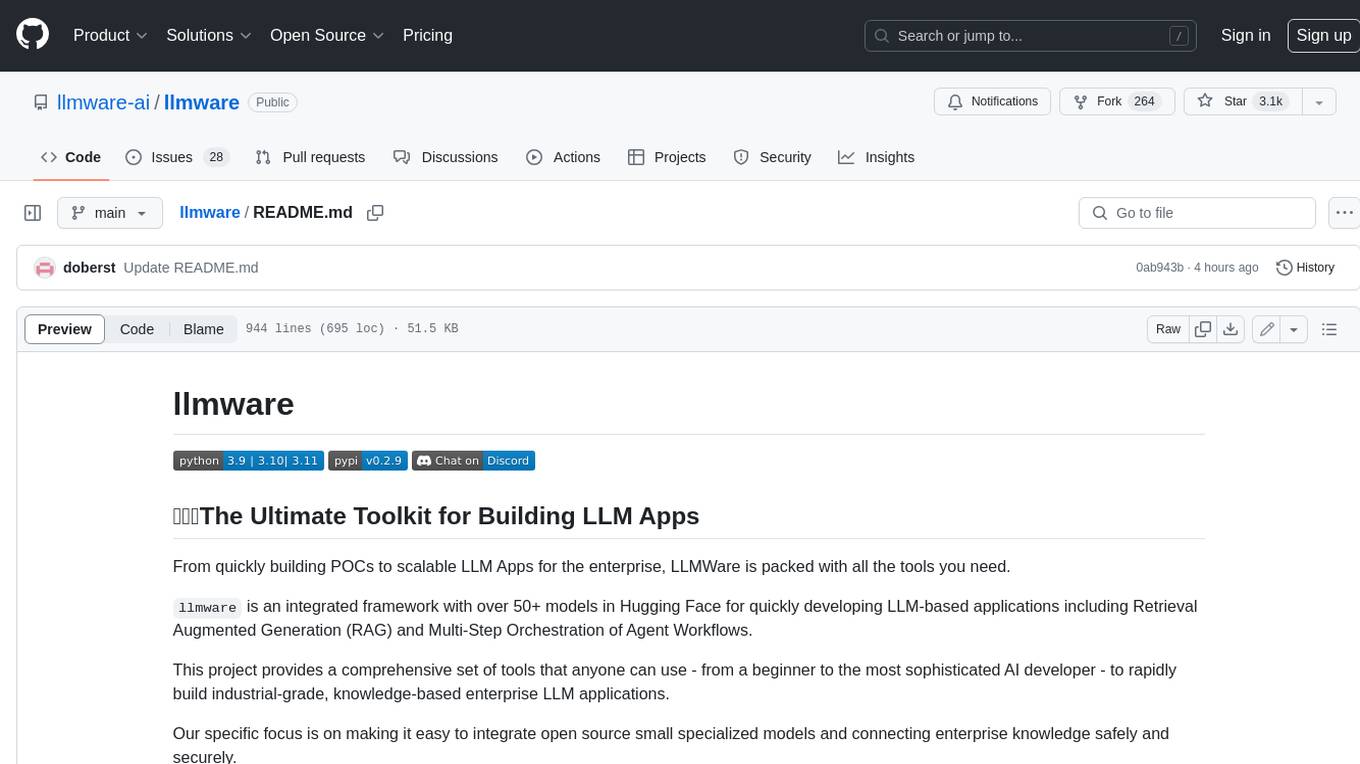
llmware
LLMWare is a framework for quickly developing LLM-based applications including Retrieval Augmented Generation (RAG) and Multi-Step Orchestration of Agent Workflows. This project provides a comprehensive set of tools that anyone can use - from a beginner to the most sophisticated AI developer - to rapidly build industrial-grade, knowledge-based enterprise LLM applications. Our specific focus is on making it easy to integrate open source small specialized models and connecting enterprise knowledge safely and securely.
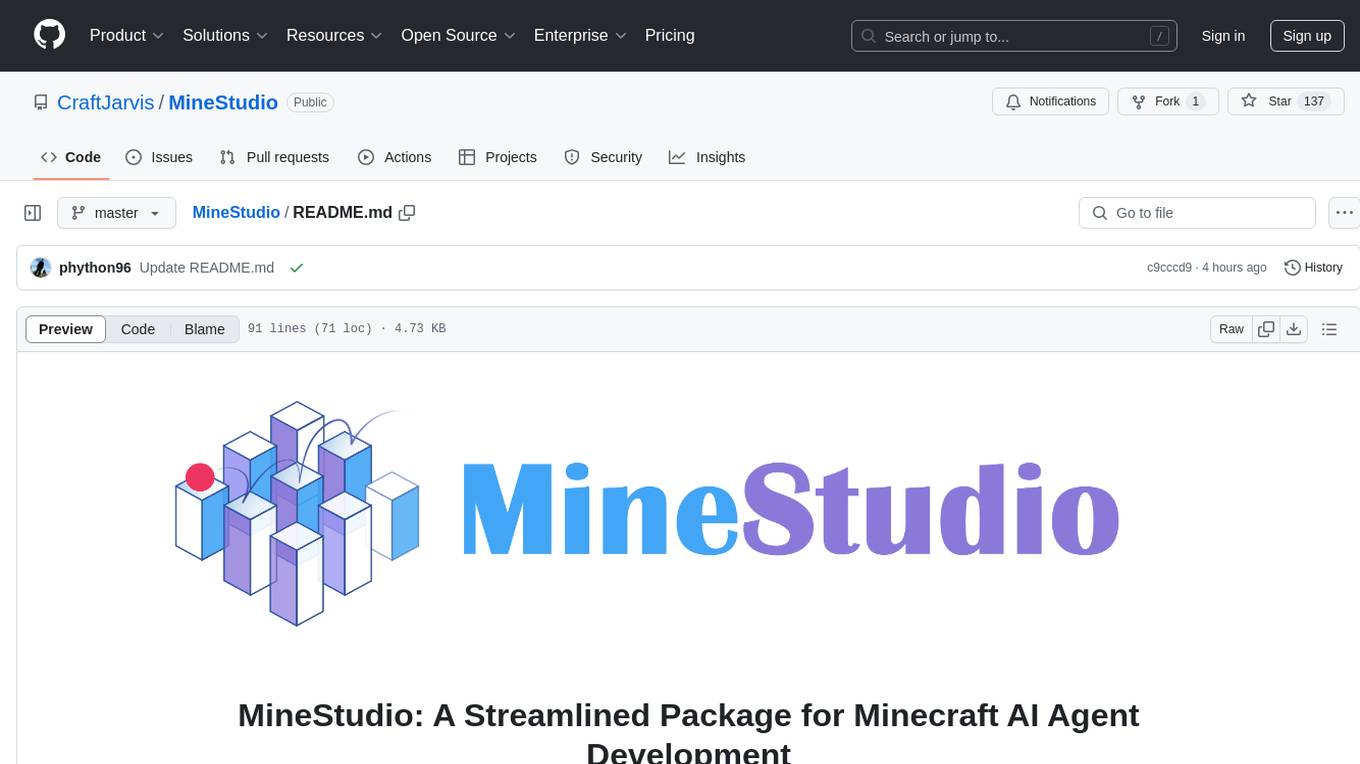
MineStudio
MineStudio is a simple and efficient Minecraft development kit for AI research. It contains tools and APIs for developing Minecraft AI agents, including a customizable simulator, trajectory data structure, policy models, offline and online training pipelines, inference framework, and benchmarking automation. The repository is under development and welcomes contributions and suggestions.
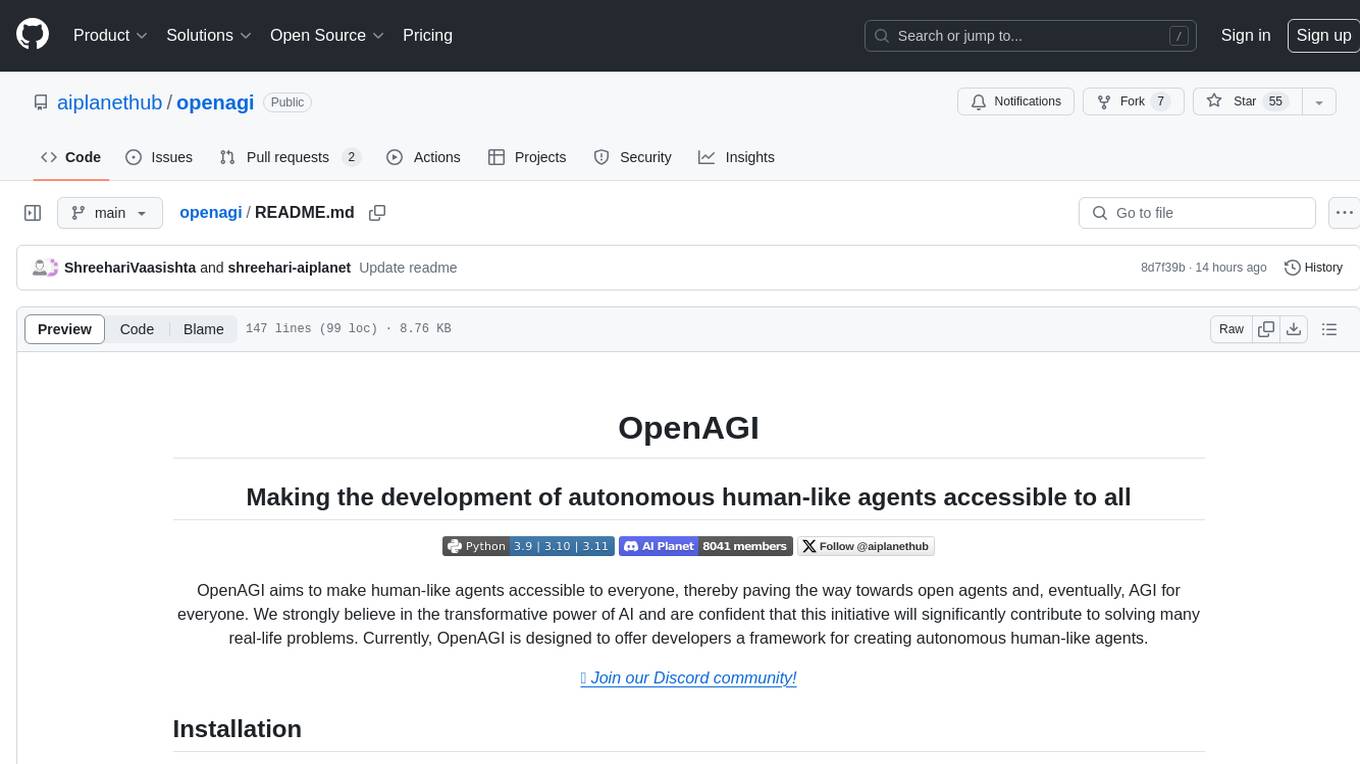
openagi
OpenAGI is a framework designed to make the development of autonomous human-like agents accessible to all. It aims to pave the way towards open agents and eventually AGI for everyone. The initiative strongly believes in the transformative power of AI and offers developers a platform to create autonomous human-like agents. OpenAGI features a flexible agent architecture, streamlined integration and configuration processes, and automated/manual agent configuration generation. It can be used in education for personalized learning experiences, in finance and banking for fraud detection and personalized banking advice, and in healthcare for patient monitoring and disease diagnosis.
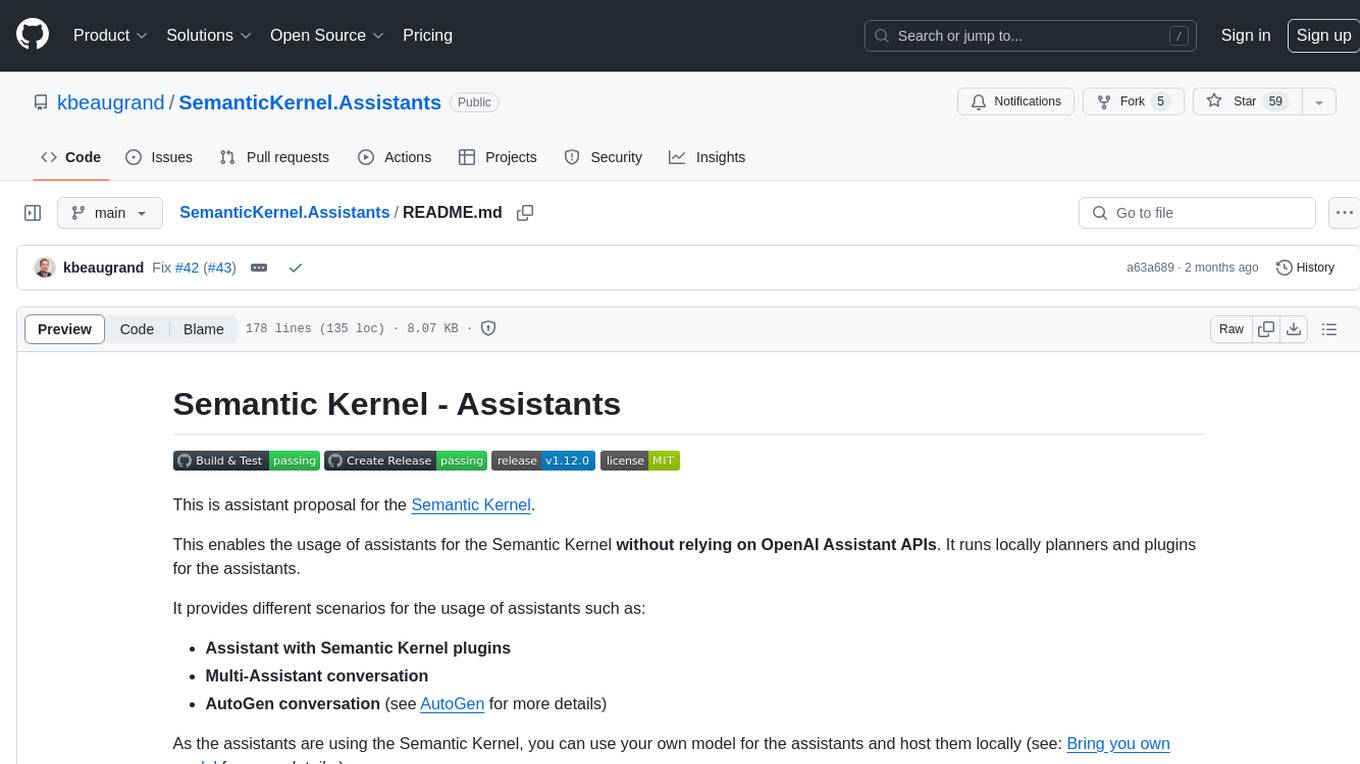
SemanticKernel.Assistants
This repository contains an assistant proposal for the Semantic Kernel, allowing the usage of assistants without relying on OpenAI Assistant APIs. It runs locally planners and plugins for the assistants, providing scenarios like Assistant with Semantic Kernel plugins, Multi-Assistant conversation, and AutoGen conversation. The Semantic Kernel is a lightweight SDK enabling integration of AI Large Language Models with conventional programming languages, offering functions like semantic functions, native functions, and embeddings-based memory. Users can bring their own model for the assistants and host them locally. The repository includes installation instructions, usage examples, and information on creating new conversation threads with the assistant.
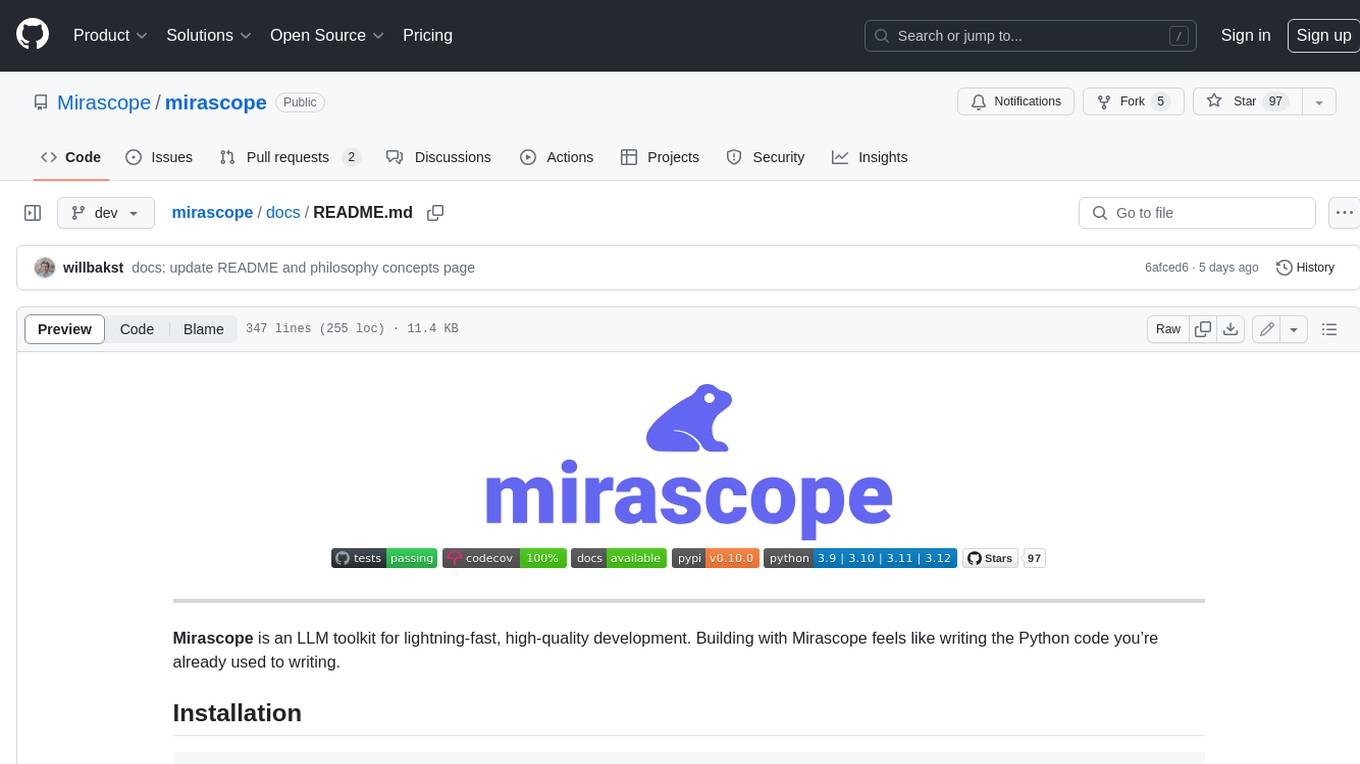
mirascope
Mirascope is an LLM toolkit for lightning-fast, high-quality development. Building with Mirascope feels like writing the Python code you’re already used to writing.
For similar tasks
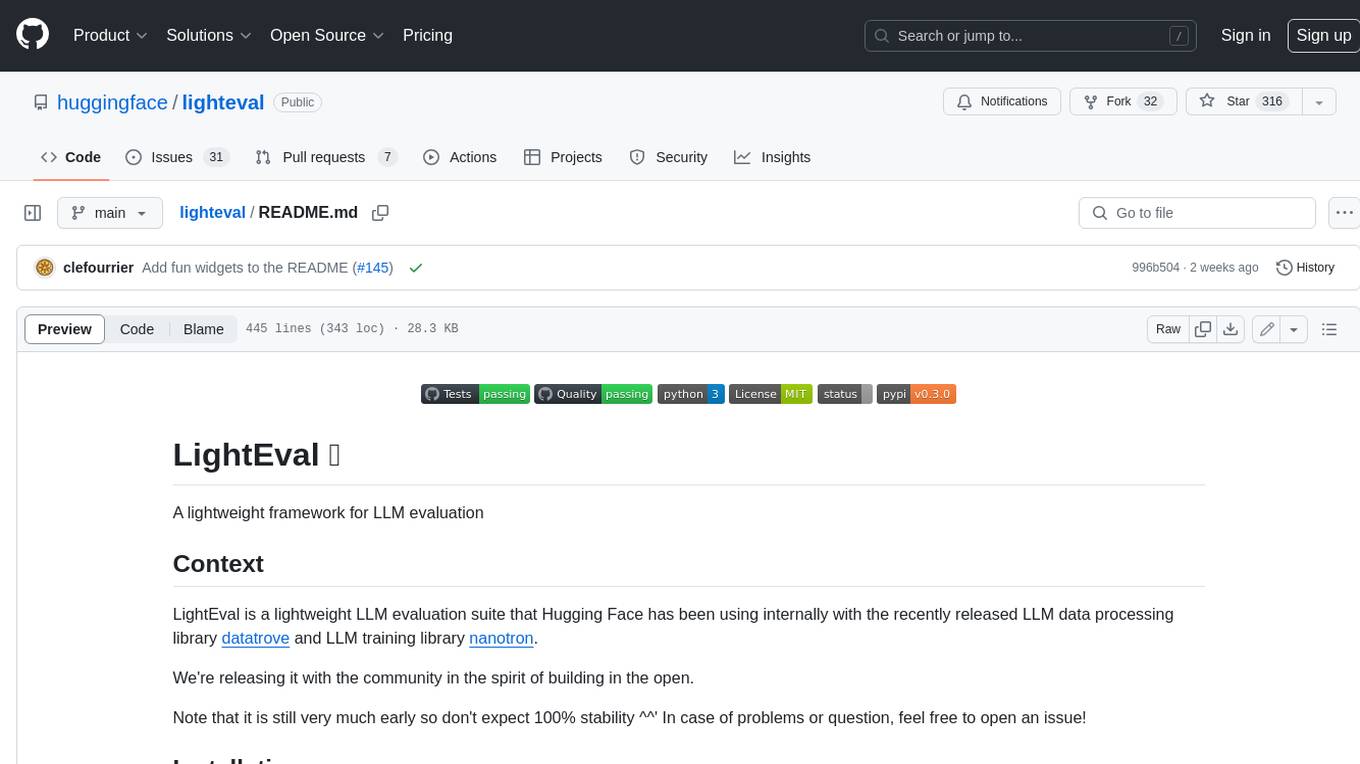
lighteval
LightEval is a lightweight LLM evaluation suite that Hugging Face has been using internally with the recently released LLM data processing library datatrove and LLM training library nanotron. We're releasing it with the community in the spirit of building in the open. Note that it is still very much early so don't expect 100% stability ^^' In case of problems or question, feel free to open an issue!
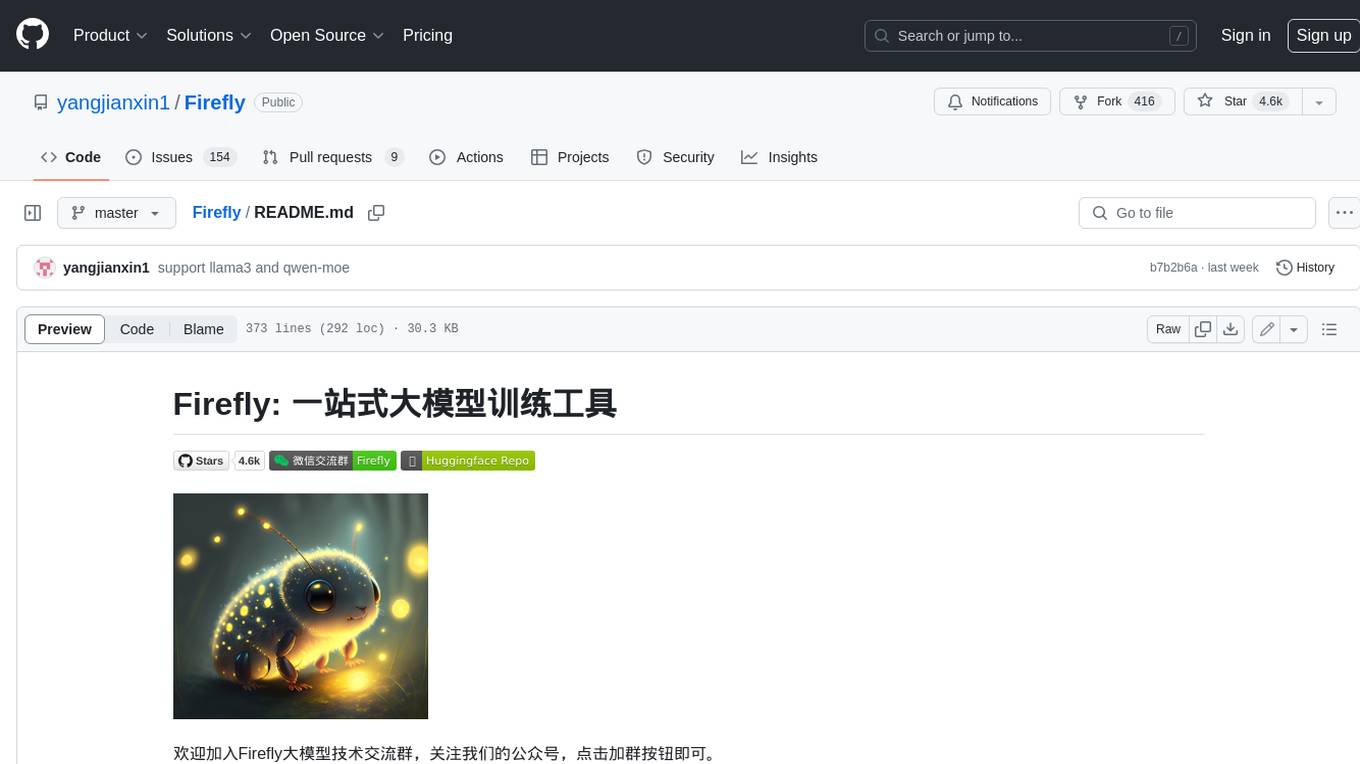
Firefly
Firefly is an open-source large model training project that supports pre-training, fine-tuning, and DPO of mainstream large models. It includes models like Llama3, Gemma, Qwen1.5, MiniCPM, Llama, InternLM, Baichuan, ChatGLM, Yi, Deepseek, Qwen, Orion, Ziya, Xverse, Mistral, Mixtral-8x7B, Zephyr, Vicuna, Bloom, etc. The project supports full-parameter training, LoRA, QLoRA efficient training, and various tasks such as pre-training, SFT, and DPO. Suitable for users with limited training resources, QLoRA is recommended for fine-tuning instructions. The project has achieved good results on the Open LLM Leaderboard with QLoRA training process validation. The latest version has significant updates and adaptations for different chat model templates.
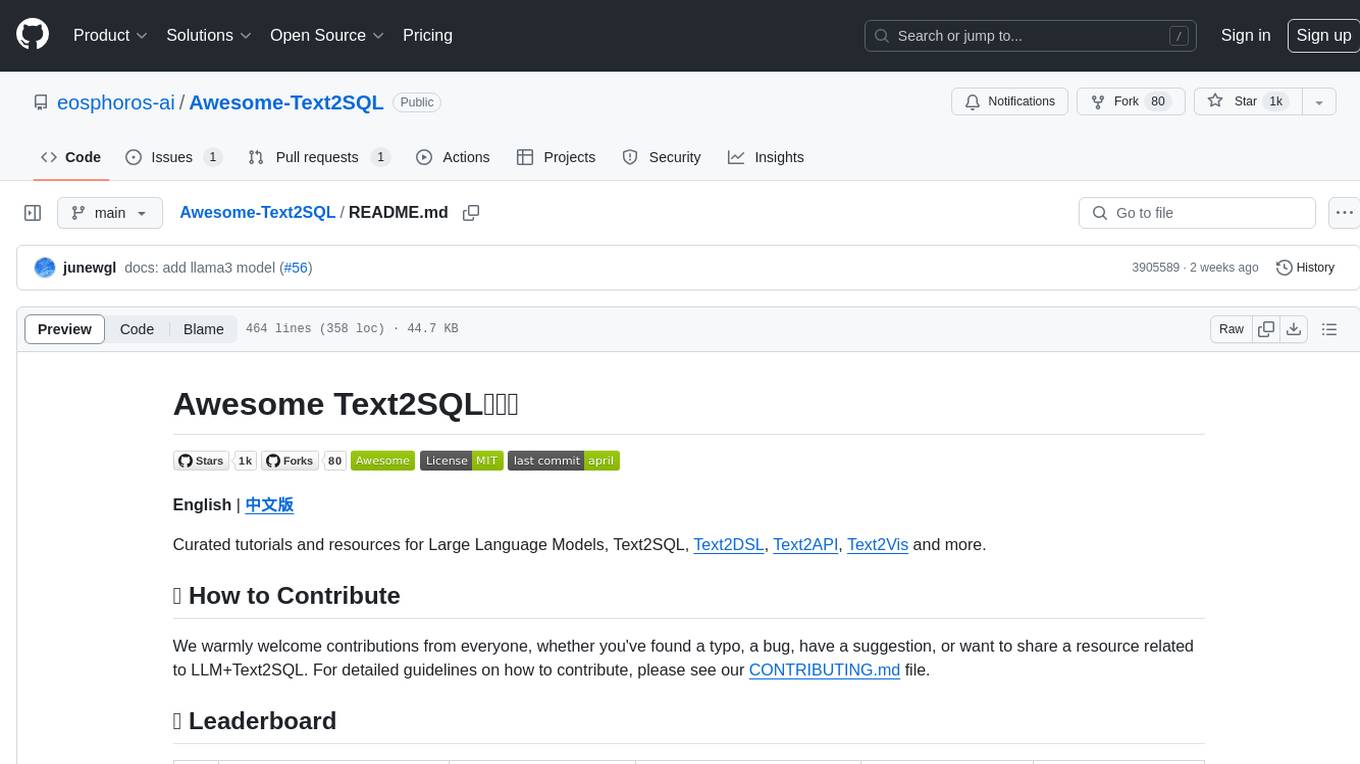
Awesome-Text2SQL
Awesome Text2SQL is a curated repository containing tutorials and resources for Large Language Models, Text2SQL, Text2DSL, Text2API, Text2Vis, and more. It provides guidelines on converting natural language questions into structured SQL queries, with a focus on NL2SQL. The repository includes information on various models, datasets, evaluation metrics, fine-tuning methods, libraries, and practice projects related to Text2SQL. It serves as a comprehensive resource for individuals interested in working with Text2SQL and related technologies.
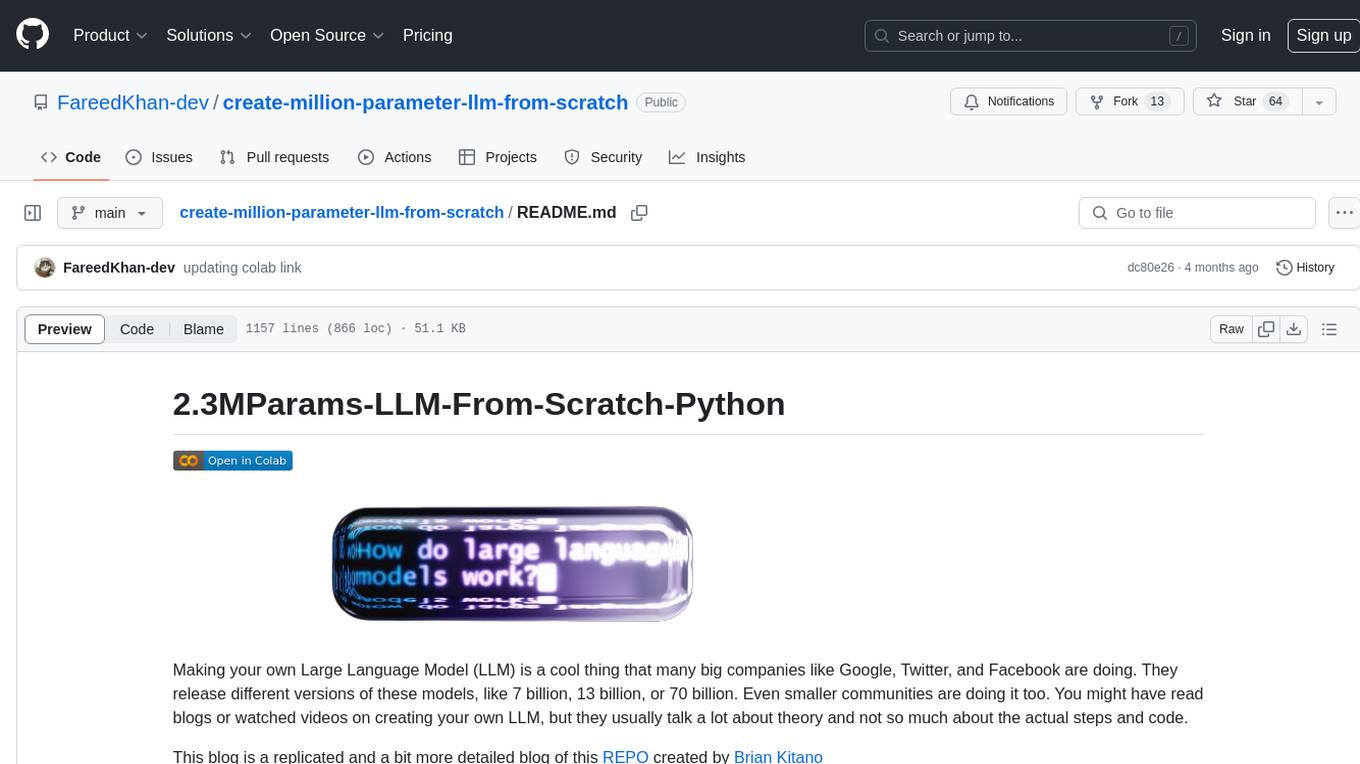
create-million-parameter-llm-from-scratch
The 'create-million-parameter-llm-from-scratch' repository provides a detailed guide on creating a Large Language Model (LLM) with 2.3 million parameters from scratch. The blog replicates the LLaMA approach, incorporating concepts like RMSNorm for pre-normalization, SwiGLU activation function, and Rotary Embeddings. The model is trained on a basic dataset to demonstrate the ease of creating a million-parameter LLM without the need for a high-end GPU.
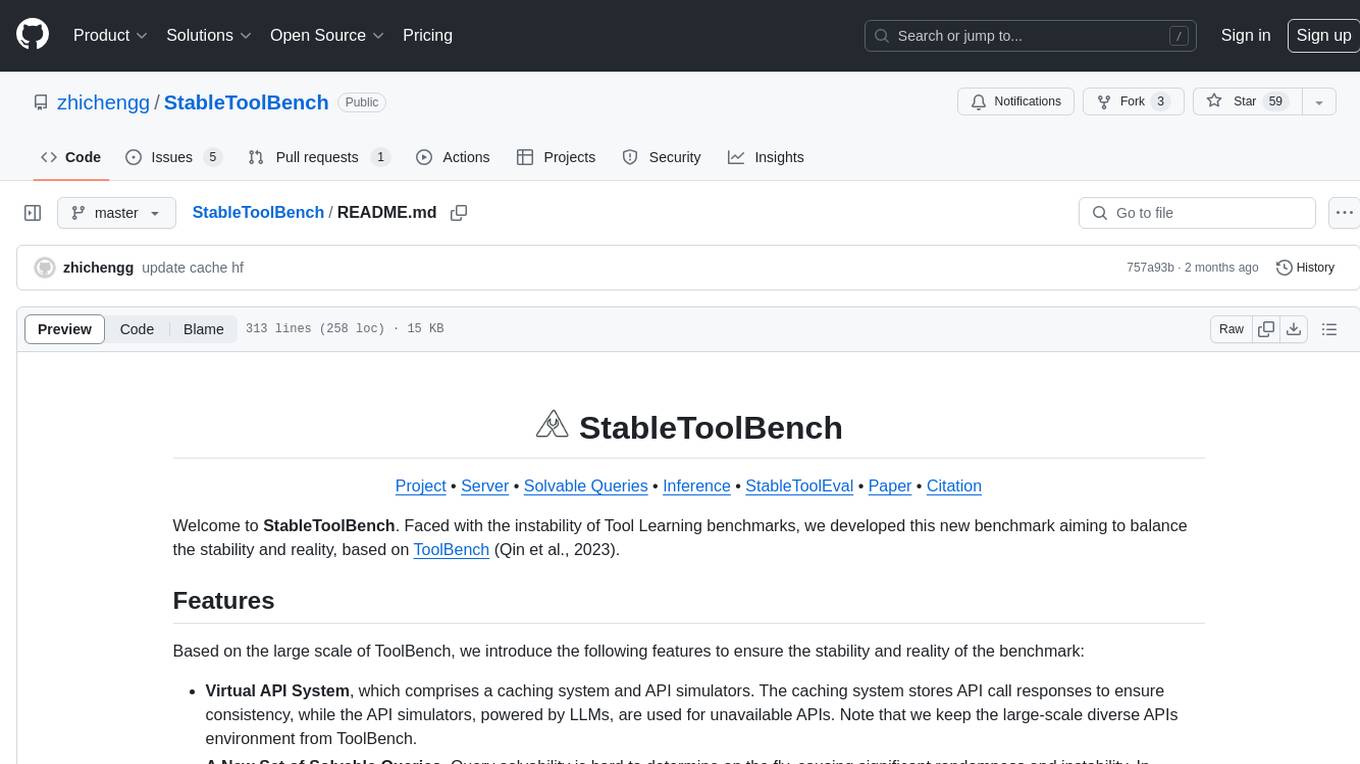
StableToolBench
StableToolBench is a new benchmark developed to address the instability of Tool Learning benchmarks. It aims to balance stability and reality by introducing features such as a Virtual API System with caching and API simulators, a new set of solvable queries determined by LLMs, and a Stable Evaluation System using GPT-4. The Virtual API Server can be set up either by building from source or using a prebuilt Docker image. Users can test the server using provided scripts and evaluate models with Solvable Pass Rate and Solvable Win Rate metrics. The tool also includes model experiments results comparing different models' performance.
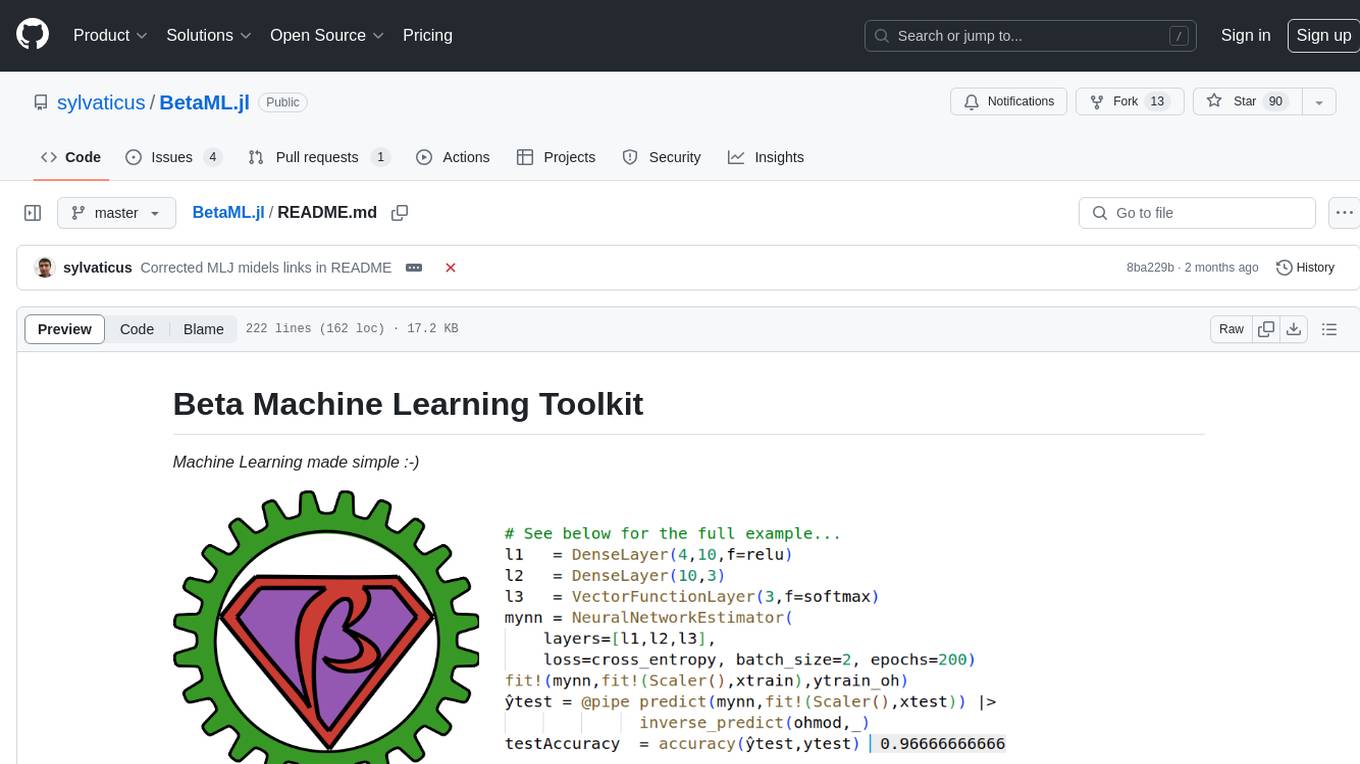
BetaML.jl
The Beta Machine Learning Toolkit is a package containing various algorithms and utilities for implementing machine learning workflows in multiple languages, including Julia, Python, and R. It offers a range of supervised and unsupervised models, data transformers, and assessment tools. The models are implemented entirely in Julia and are not wrappers for third-party models. Users can easily contribute new models or request implementations. The focus is on user-friendliness rather than computational efficiency, making it suitable for educational and research purposes.
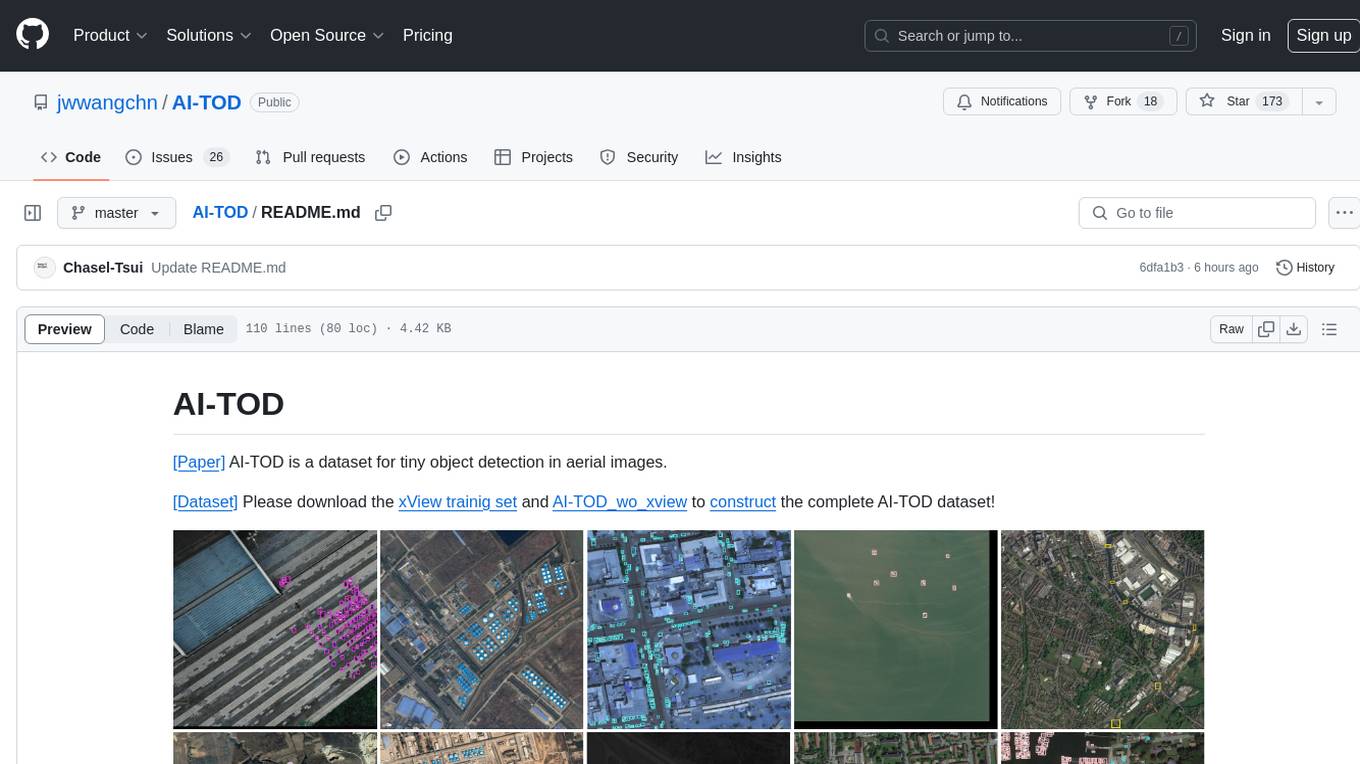
AI-TOD
AI-TOD is a dataset for tiny object detection in aerial images, containing 700,621 object instances across 28,036 images. Objects in AI-TOD are smaller with a mean size of 12.8 pixels compared to other aerial image datasets. To use AI-TOD, download xView training set and AI-TOD_wo_xview, then generate the complete dataset using the provided synthesis tool. The dataset is publicly available for academic and research purposes under CC BY-NC-SA 4.0 license.
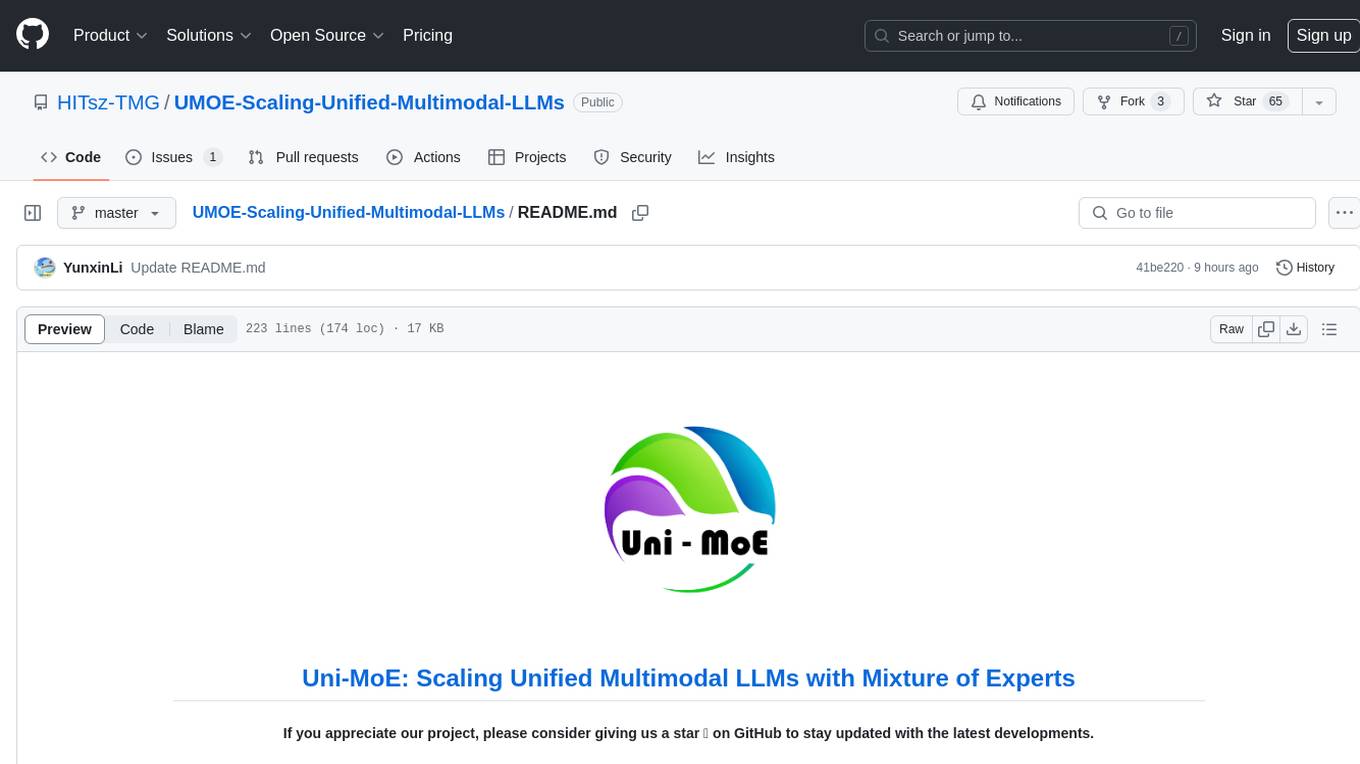
UMOE-Scaling-Unified-Multimodal-LLMs
Uni-MoE is a MoE-based unified multimodal model that can handle diverse modalities including audio, speech, image, text, and video. The project focuses on scaling Unified Multimodal LLMs with a Mixture of Experts framework. It offers enhanced functionality for training across multiple nodes and GPUs, as well as parallel processing at both the expert and modality levels. The model architecture involves three training stages: building connectors for multimodal understanding, developing modality-specific experts, and incorporating multiple trained experts into LLMs using the LoRA technique on mixed multimodal data. The tool provides instructions for installation, weights organization, inference, training, and evaluation on various datasets.
For similar jobs

weave
Weave is a toolkit for developing Generative AI applications, built by Weights & Biases. With Weave, you can log and debug language model inputs, outputs, and traces; build rigorous, apples-to-apples evaluations for language model use cases; and organize all the information generated across the LLM workflow, from experimentation to evaluations to production. Weave aims to bring rigor, best-practices, and composability to the inherently experimental process of developing Generative AI software, without introducing cognitive overhead.

LLMStack
LLMStack is a no-code platform for building generative AI agents, workflows, and chatbots. It allows users to connect their own data, internal tools, and GPT-powered models without any coding experience. LLMStack can be deployed to the cloud or on-premise and can be accessed via HTTP API or triggered from Slack or Discord.

VisionCraft
The VisionCraft API is a free API for using over 100 different AI models. From images to sound.

kaito
Kaito is an operator that automates the AI/ML inference model deployment in a Kubernetes cluster. It manages large model files using container images, avoids tuning deployment parameters to fit GPU hardware by providing preset configurations, auto-provisions GPU nodes based on model requirements, and hosts large model images in the public Microsoft Container Registry (MCR) if the license allows. Using Kaito, the workflow of onboarding large AI inference models in Kubernetes is largely simplified.

PyRIT
PyRIT is an open access automation framework designed to empower security professionals and ML engineers to red team foundation models and their applications. It automates AI Red Teaming tasks to allow operators to focus on more complicated and time-consuming tasks and can also identify security harms such as misuse (e.g., malware generation, jailbreaking), and privacy harms (e.g., identity theft). The goal is to allow researchers to have a baseline of how well their model and entire inference pipeline is doing against different harm categories and to be able to compare that baseline to future iterations of their model. This allows them to have empirical data on how well their model is doing today, and detect any degradation of performance based on future improvements.

tabby
Tabby is a self-hosted AI coding assistant, offering an open-source and on-premises alternative to GitHub Copilot. It boasts several key features: * Self-contained, with no need for a DBMS or cloud service. * OpenAPI interface, easy to integrate with existing infrastructure (e.g Cloud IDE). * Supports consumer-grade GPUs.

spear
SPEAR (Simulator for Photorealistic Embodied AI Research) is a powerful tool for training embodied agents. It features 300 unique virtual indoor environments with 2,566 unique rooms and 17,234 unique objects that can be manipulated individually. Each environment is designed by a professional artist and features detailed geometry, photorealistic materials, and a unique floor plan and object layout. SPEAR is implemented as Unreal Engine assets and provides an OpenAI Gym interface for interacting with the environments via Python.

Magick
Magick is a groundbreaking visual AIDE (Artificial Intelligence Development Environment) for no-code data pipelines and multimodal agents. Magick can connect to other services and comes with nodes and templates well-suited for intelligent agents, chatbots, complex reasoning systems and realistic characters.
